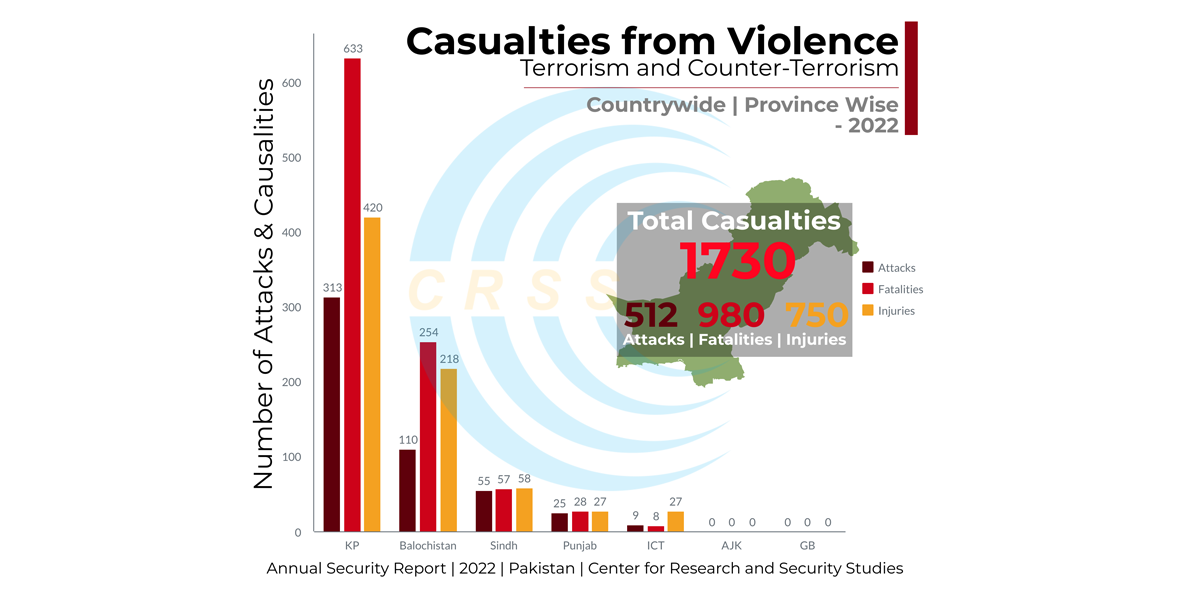Casualties from Terror Attacks and Counter-Terror Operations
Terrorist violence touched a new height in 2022. From 850 fatalities in 2021, the figure jumped to 980 in 2022 – indicating an over 15 percent rise in violence from as many as 512 terrorist incidents and counter-terror operations. The highest rise in violence was recorded in Khyber Pakhtunkhwa (KP), where fatalities went up from 399 in 2021 to 633 this year – a nearly 59% rise. Balochistan recorded a marginal increase of 1% in violence but it could not bring any relief to the region as it had the second-highest number of fatalities in the country. All other regions witnessed a drop in violence with Punjab, the largest province of the country, recorded a 61% drop in violence, followed by Sindh 50% down, and Islamabad Capital Territory (ICT) registered an 11% decline, while Gilgit Baltistan (GB) had no incident of violence this year (Table 01-A and Table 01-B).
Both KP and Balochistan together suffered nearly 90 percent of all fatalities across the country, with the last month of the year i.e., December emerging as the deadliest for the security forces that lost at least 42 personnel in over two dozen attacks.
Officials attributed the concentration of violence in KP and Balochistan to the return of the Taliban to power in Afghanistan, where thousands of Pakistani militants and wanted terrorists – mostly linked to the banned Tehreek-e-Taliban Pakistan (TTP) – reportedly enjoy safe havens and the necessary support for planning acts of terror in Pakistan.
TTP demands the restoration of seven former FATA (Federally Administered Tribal Areas) regions that had been merged with KP in May 2018. The terrorist group also wants the army to withdraw from the region, where it desires to replicate the Islamic caliphate model as enforced by the Afghan Taliban. On November 28, the group also called off a ceasefire agreement it had agreed to in June 2021.
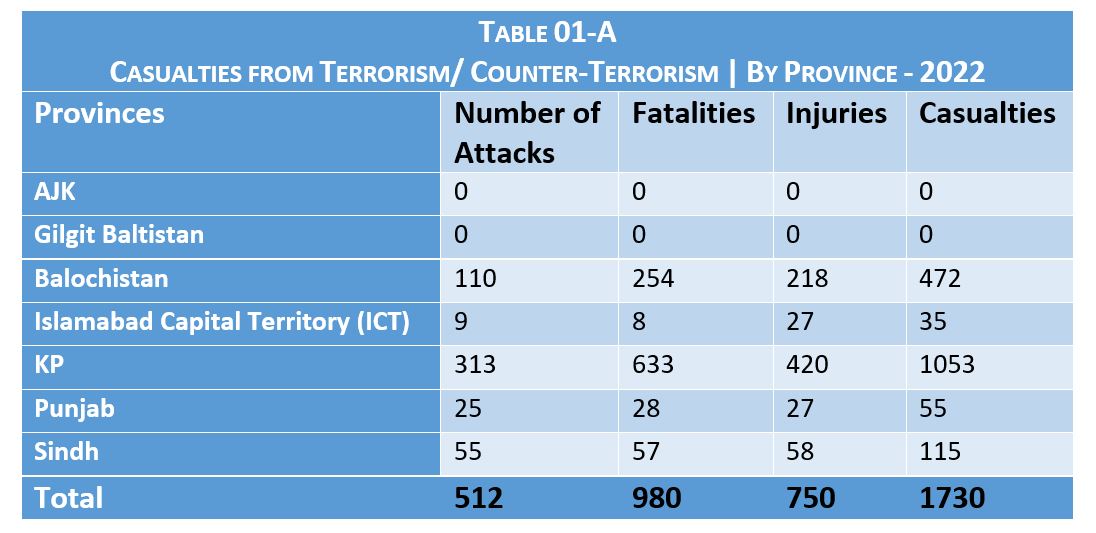
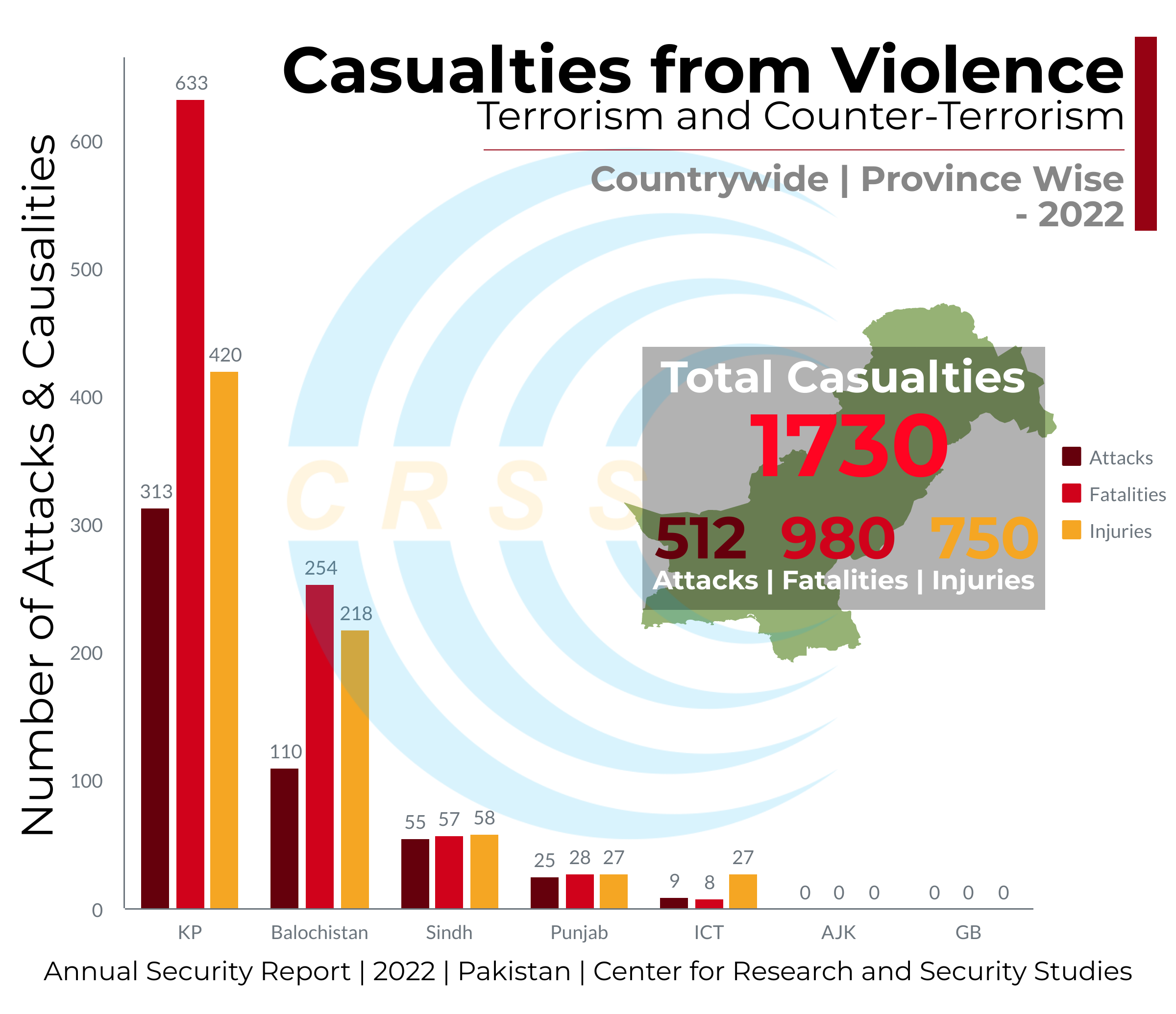
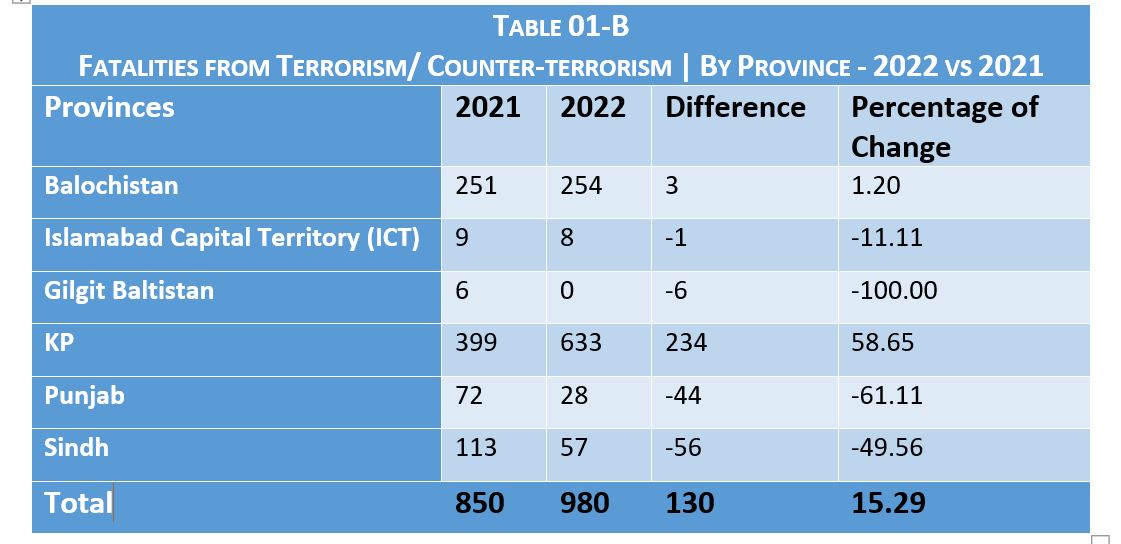

Comparing casualties of violence and counter-violence yields a very precarious security situation wherein terrorism appeared to have caused 77% of casualties while 22% of casualties resulted from operations by security agencies. The terror attacks, as evident, were highly fatalistic and injurious giving an edge to the banned outfit like TTP.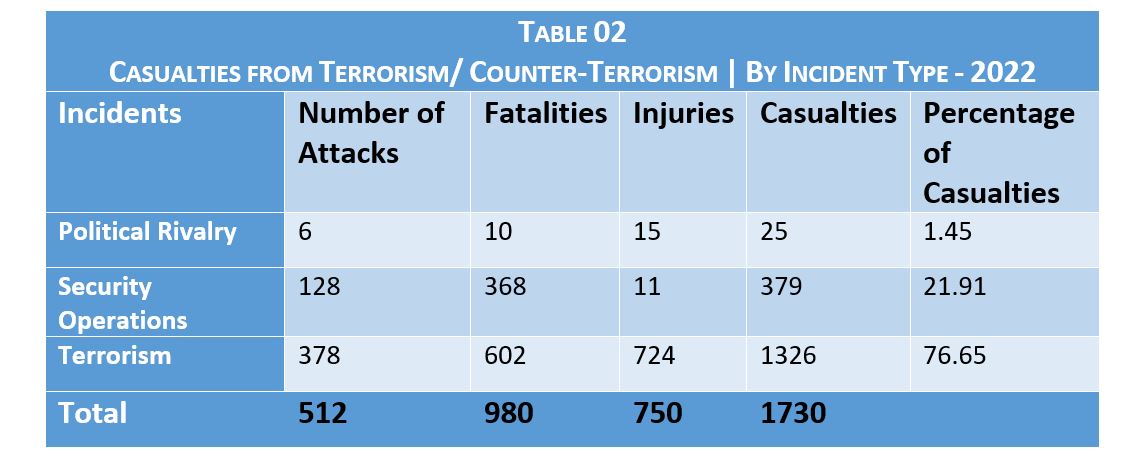
 Fortunately, no human loss was reported in at least 19 terror attacks except for some damages to property. The majority of them were reported from KP and Balochistan. ICT and Sindh also recorded one each attack (Table 03).
Fortunately, no human loss was reported in at least 19 terror attacks except for some damages to property. The majority of them were reported from KP and Balochistan. ICT and Sindh also recorded one each attack (Table 03). The apparent objective of these failed attacks was to stoke fear and uncertainty among the targets and/or make them agree to demands (which in many cases is either release of prisoners or extortion). Such attacks targeted about ten security check posts, two leaders of mainstream political parties (PTI & JUI)[1], two industries, one government hospital, and the residence of an Awami National Party (ANP) leader twice.
The apparent objective of these failed attacks was to stoke fear and uncertainty among the targets and/or make them agree to demands (which in many cases is either release of prisoners or extortion). Such attacks targeted about ten security check posts, two leaders of mainstream political parties (PTI & JUI)[1], two industries, one government hospital, and the residence of an Awami National Party (ANP) leader twice.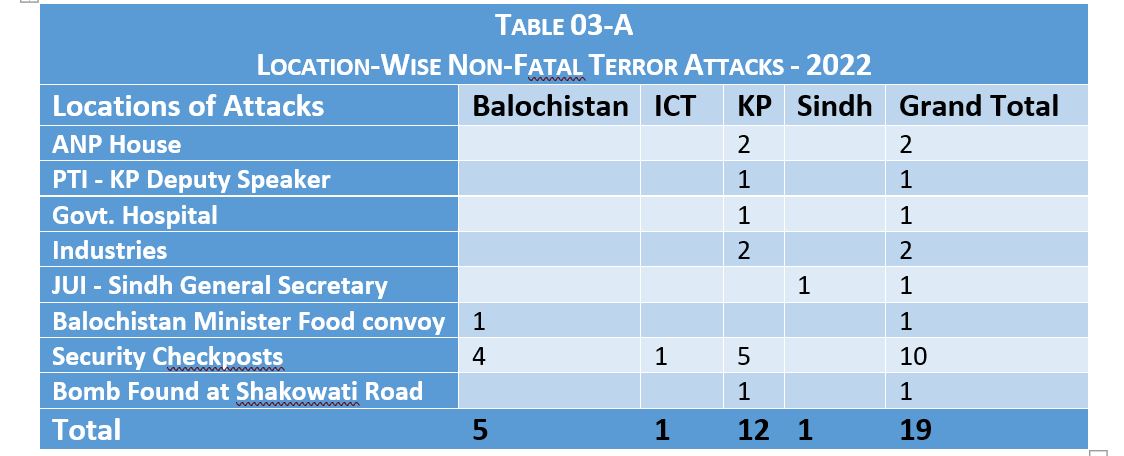 The weapons and methods used in these non-fatal attacks also indicate the lethality and the extent of fear they may have instilled among the targeted locations/groups. Nine armed attacks were carried out at different locations in Balochistan and KP, two bomb explosions in KP, six incidents of firing at different places in Balochistan, ICT, KP, and Sindh, including four hand-grenade attacks in Balochistan and KP, and an RPG strike at security posts. (Table 03-B).
The weapons and methods used in these non-fatal attacks also indicate the lethality and the extent of fear they may have instilled among the targeted locations/groups. Nine armed attacks were carried out at different locations in Balochistan and KP, two bomb explosions in KP, six incidents of firing at different places in Balochistan, ICT, KP, and Sindh, including four hand-grenade attacks in Balochistan and KP, and an RPG strike at security posts. (Table 03-B).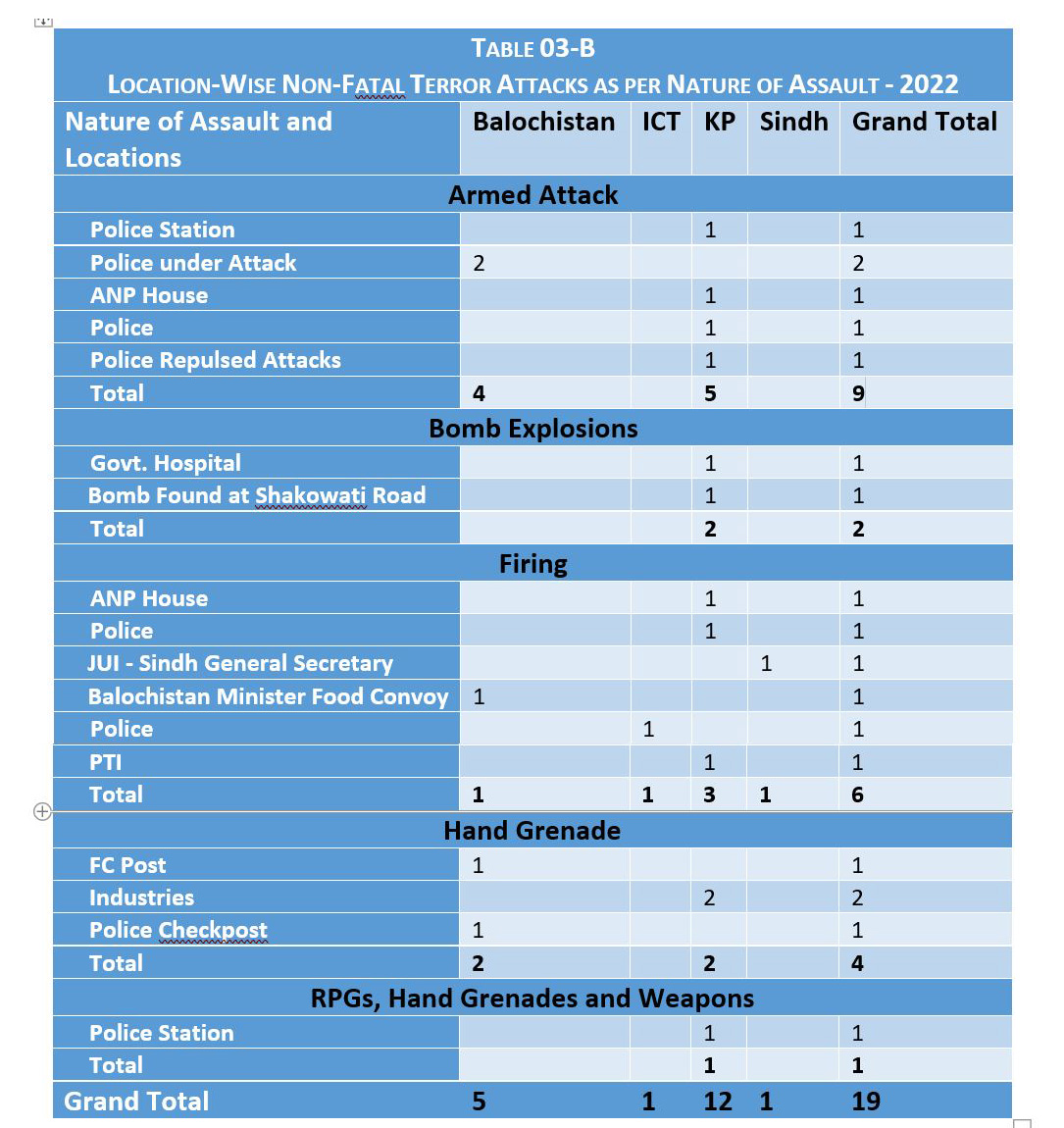 The monthly trend of violence and counter-violence underlines a continuous stand-off between the security agencies and the terrorists/outlaws. In February, the militants suffered more fatalities than civilians and security personnel together. Fatalities of civilian and security personnel in March were thrice the fatalities of the militants, but in May, these numbers came down to only one-fourth of the total fatalities of civilians and security personnel. From June till the end of December, the fatalities among civilians and security personnel remained higher than the fatalities of militants – a daunting scenario highlighting the magnitude of the threat outlaws pose to security agencies (Table 04).
The monthly trend of violence and counter-violence underlines a continuous stand-off between the security agencies and the terrorists/outlaws. In February, the militants suffered more fatalities than civilians and security personnel together. Fatalities of civilian and security personnel in March were thrice the fatalities of the militants, but in May, these numbers came down to only one-fourth of the total fatalities of civilians and security personnel. From June till the end of December, the fatalities among civilians and security personnel remained higher than the fatalities of militants – a daunting scenario highlighting the magnitude of the threat outlaws pose to security agencies (Table 04).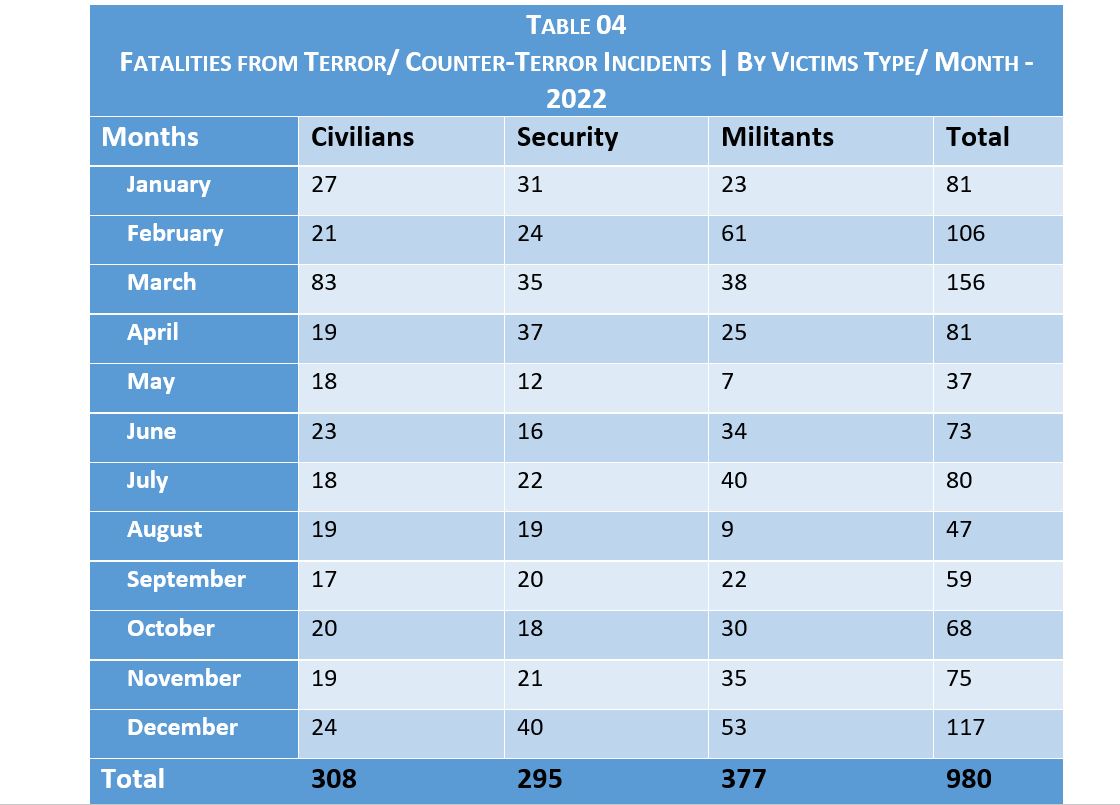

Victims of Terror Attacks and Counter-Terror Operations
The militants and insurgents appear to have suffered more fatalities from the CT operations, evident from the fact that their losses ranged around 39% of the total fatalities, followed by the civilian fatalities at 31% and security personnel at 30%. Taking the casualties into account, the civilians suffered the highest number of casualties which stood around 48%, followed by 30% of the security personnel, The militants, on the other hand, suffered only 22% casualties (Table 05).
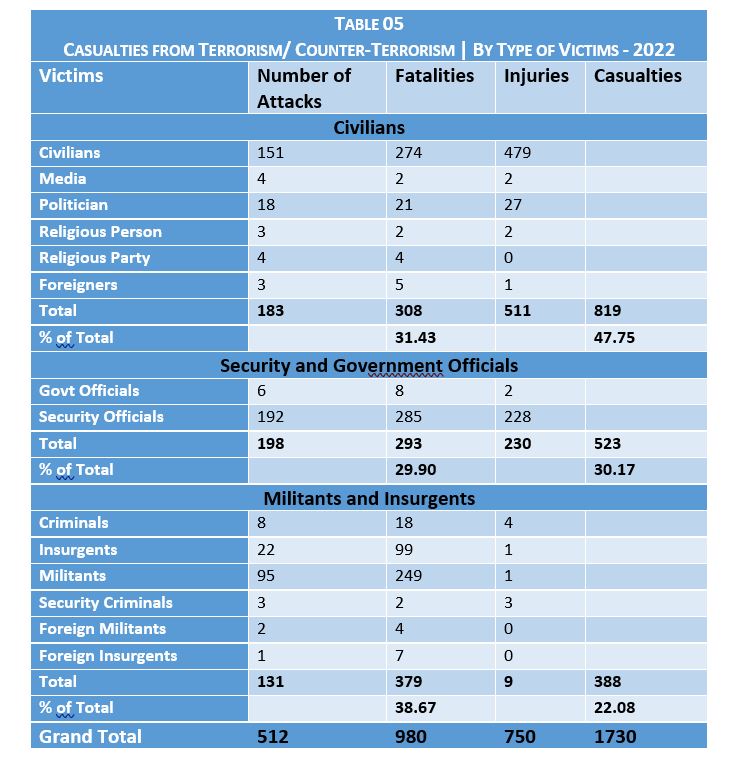
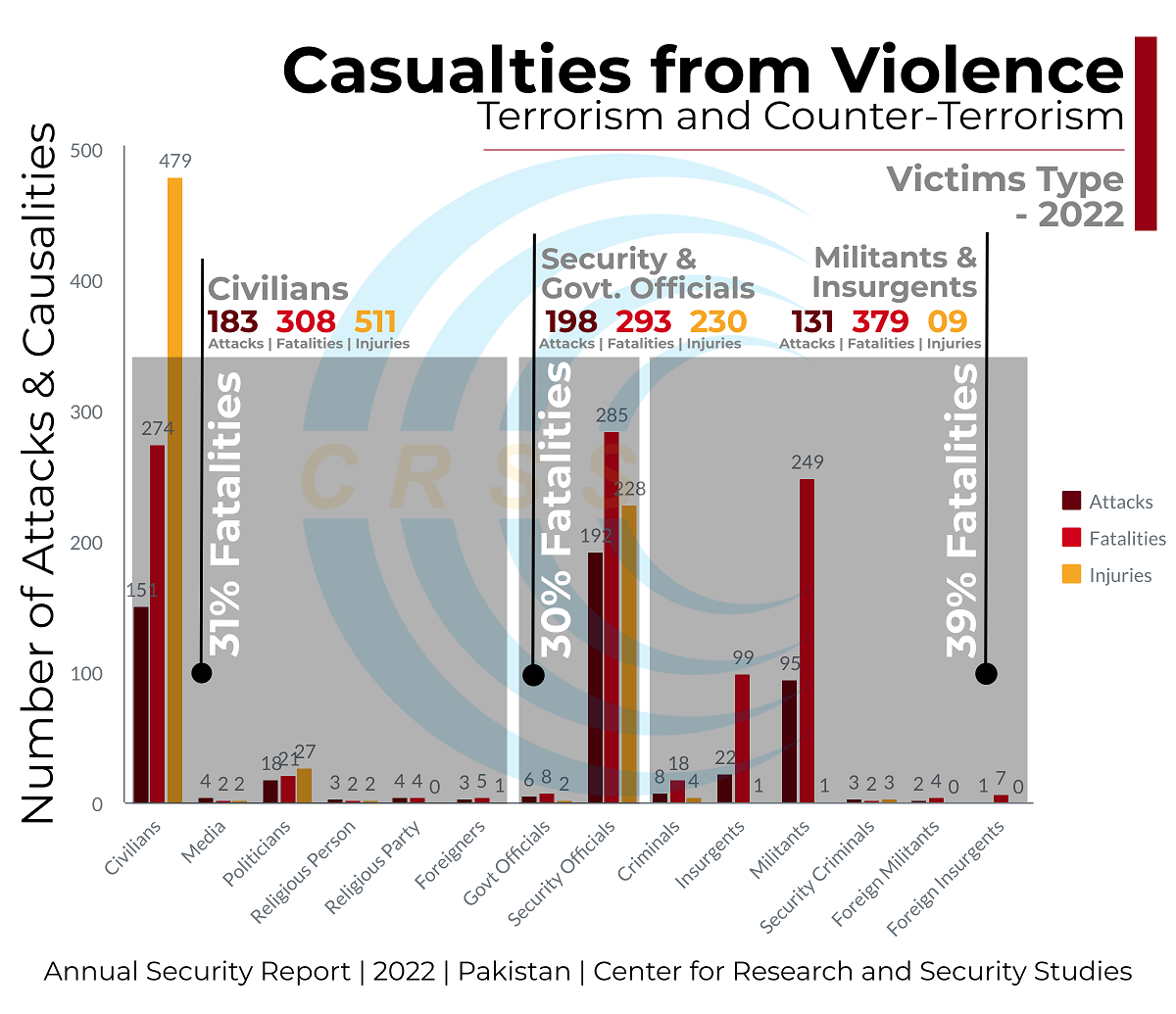 Security Operations
Security Operations
During 2022, security agencies carried out at least 128 operations against militants and insurgents, leaving 368 dead and 11 injured. The majority of these operations were carried out in KP and Balochistan (Table 06).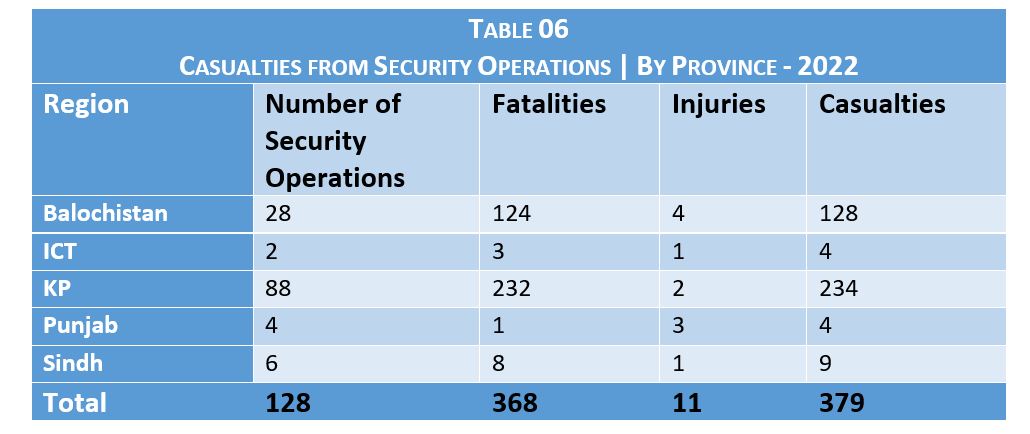
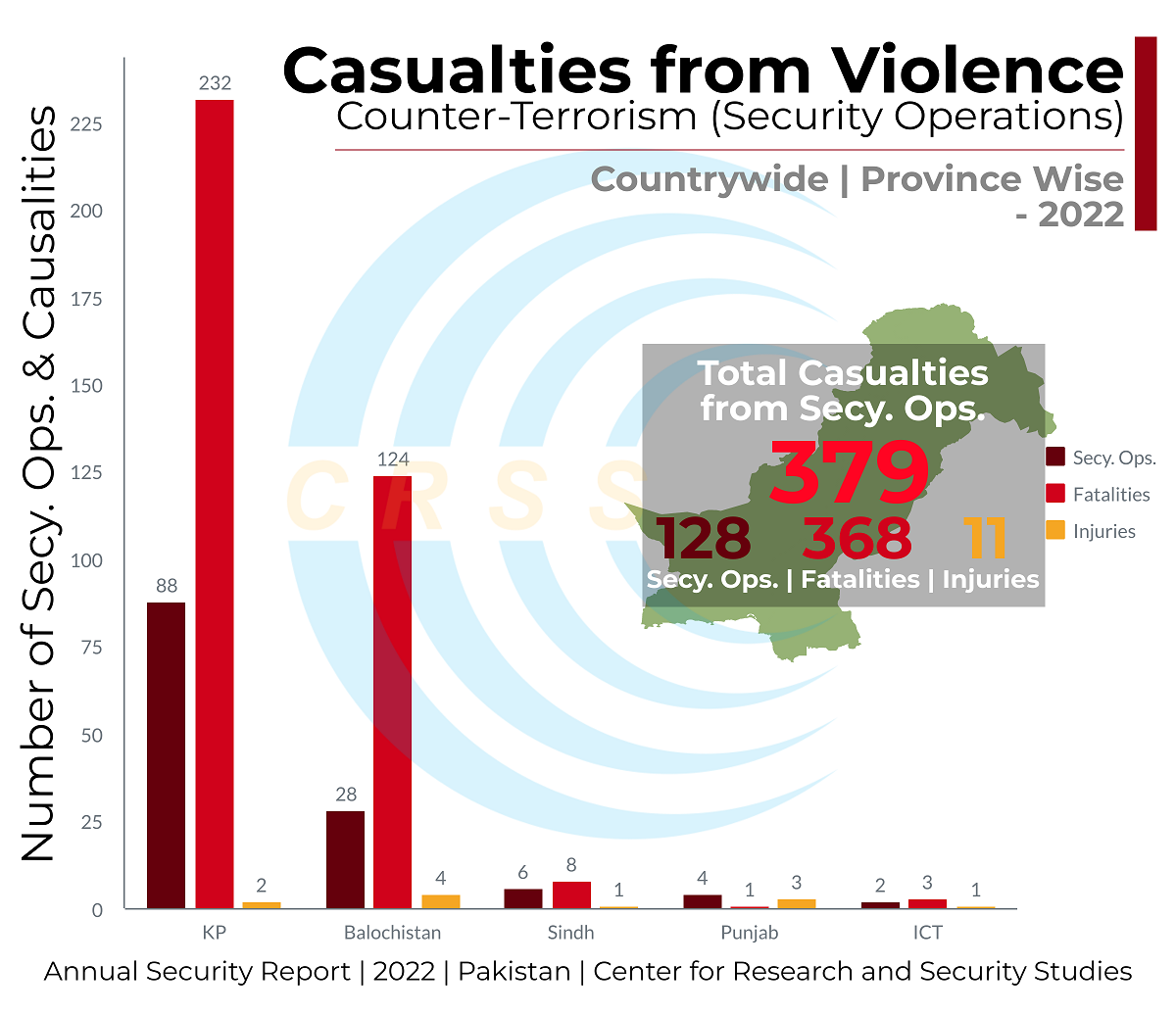
Militants and insurgents had the highest number of fatalities from security operations while a few civilians also became victims of security operations because of reasons varying from the intent to create panic to the trigger-happy tendencies of some security personnel. One such incident in Balochistan had serious repercussions as it led two political parties, BNP-M and ANP, to disassociate themselves from their alliance with the government in protest[1] (Table 07).
Among the outlaws eliminated in security operations, TTP lost 63 militants, followed by Da’ish (or ISI-K) which lost 24 militants and there were 5 Afghan-based militants and an Afghan Taliban who mysteriously disappeared and was later found dead[2].
Involvement of foreign countries, especially Afghanistan, in harboring the militants for their nefarious design also came to the surface from the reports that identified several militants from Afghanistan who were detected and killed along the Pakistan-Afghan border areas. At least eight cross-border attacks by the Afghan-based militants at different Pakistani locations left 22 army personnel dead and 15 injured.
Three Afghan-based militants were killed in Peshawar who were handlers of a suicide bomber (who had entered the country from Afghanistan and attacked Imamia Mosque at Kocha Risaldar in Peshawar)[3]. Later, a master-mind of the Kocha Risaldar attack identified as an Afghanistan-based commander of ISI-K, formerly affiliated with TTP, was killed along with a would-be suicide bomber, an Afghani of Tajik origin, in Peshawar on 15 May 2022[4].
On 16 September, CTD killed three terrorists belonging to Da’ish near the Pakistan-Afghan border in Khyber-Pakhtunkhwa[5].
Two terrorists, killed on 10 October in Swat’s Angro Dherai area, were trained in Afghanistan for bomb manufacturing and during the clash, they were in contact with militants in Afghanistan[6].
A Bannu-based CTD information led to an operation along the Pak-Afghan border’s hilly area in Dardoni in North Waziristan that eliminated four militants belonging to Da’ish on 11 December 2022[7].
Among the insurgents who lost their lives in security operations, BLA had the highest number of their members (39), while BLF and BNA had 6 of their members, and BRA had only 2 members. Two members of the Sindh Revolutionary Army (SRA) were also killed in security operations. Some insurgents with external links were also killed during this year.
A report on 8 March revealed that seven “externally sponsored terrorists” were killed in the Gorchop area of the Turbat district in Balochistan. No identity of their affiliation was reported[8]. There were at least 40 insurgents killed in various intelligence-based operations whose identity was not disclosed.
Other criminals like drug smugglers and dacoit gangs, known as the Samba and Sardar Lalo gangs, were also eliminated this year. In Karachi, a retired Frontier Corps soldier was killed on March 21, after he had attacked and wounded three policemen due to some undeclared reason[9].
Several border conflicts between Pak-Afghan forces also took place this year but the data on those conflicts is not included in this report.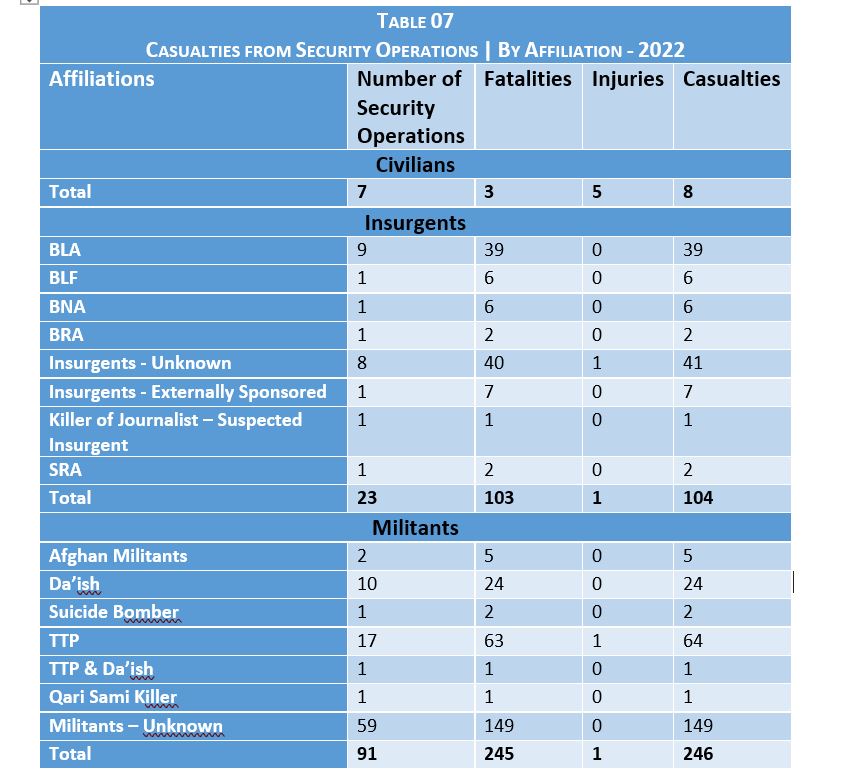
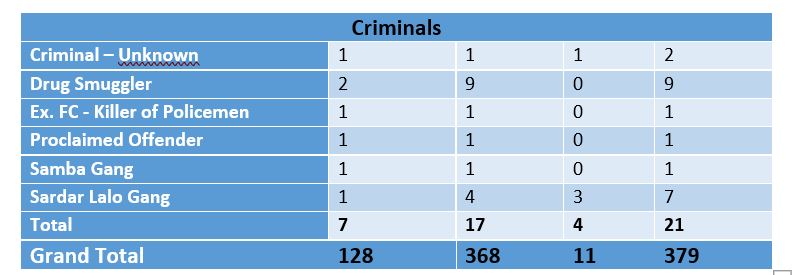
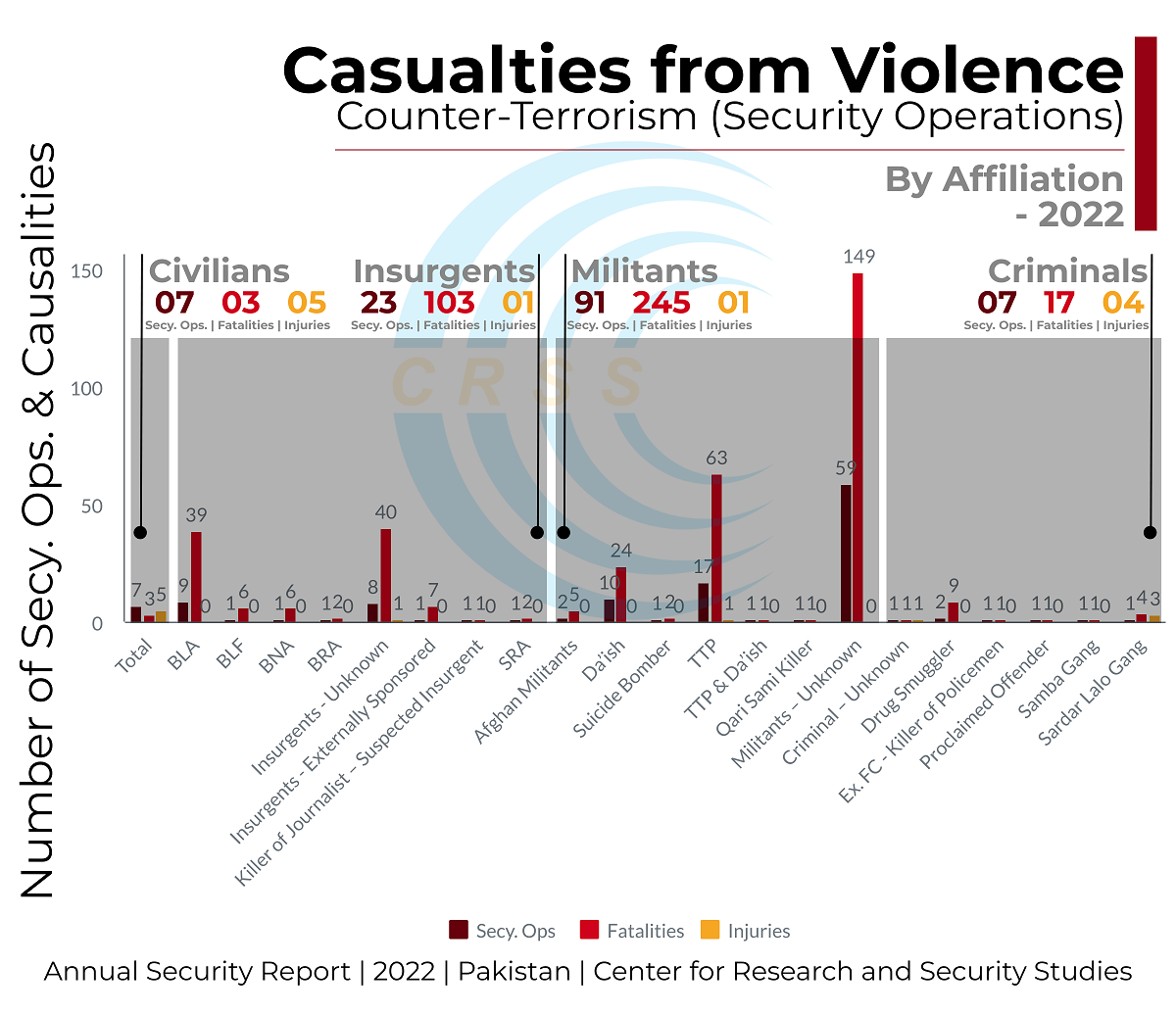 Of the 102 arrested militants in 2022 as many as 37 belonged to TTP, 10 had alleged links with the Indian intelligence agency Research and Analysis Wing (RAW), Al-Qaeda (AQ), LeJ (Lashkar-e-Jhangvi), and TTP. Some 13 were Da’ish (ISI-K) members (Table 08). A female terrorist, Reema, stated to have been involved in the attack on the Pakistan Air Force base in Badaber in 2015, was also arrested on March 31. An Afghan national, Babrak, carrying Rs 2.5 million head money, was also arrested during action on Phandu Road. Another terrorist, Lal Agha, an Afghan national carrying Rs 1.5 million head money, was also arrested in Urmar Adda[1]. Thirteen persons linked with a foreign intelligence agency were arrested in Karachi[2].
Of the 102 arrested militants in 2022 as many as 37 belonged to TTP, 10 had alleged links with the Indian intelligence agency Research and Analysis Wing (RAW), Al-Qaeda (AQ), LeJ (Lashkar-e-Jhangvi), and TTP. Some 13 were Da’ish (ISI-K) members (Table 08). A female terrorist, Reema, stated to have been involved in the attack on the Pakistan Air Force base in Badaber in 2015, was also arrested on March 31. An Afghan national, Babrak, carrying Rs 2.5 million head money, was also arrested during action on Phandu Road. Another terrorist, Lal Agha, an Afghan national carrying Rs 1.5 million head money, was also arrested in Urmar Adda[1]. Thirteen persons linked with a foreign intelligence agency were arrested in Karachi[2].
On Jan 25, 2022, the police department unearthed a secret cyber network of the Indian prime intel agency Research and Analysis Wing (RAW) in Karachi[3].
Balochistan police arrested a potential female suicide bomber, associated with the Baloch Liberation Army (BLA) on May 16. She had planned to blow herself up near a convoy of Chinese nationals associated with the China-Pakistan Economic Corridor (CPEC)[4] projects. It is a new and unprecedented phenomenon used by the Baloch insurgent group. Only about two weeks earlier, a woman suicide bomber had blown herself up on a university campus in Karachi, killing three Chinese teachers and their Pakistani driver. She, too, belonged to the Baloch Liberation Army (BLA)[5]. At least 25 insurgents were arrested during the year. The majority of them belonged to Baloch outfits BLA, SRA (Sindhudesh Revolutionary Army), BNA (Baloch Nationalist Army), BRG (Baloch Republican Guard), and others (Table 08).
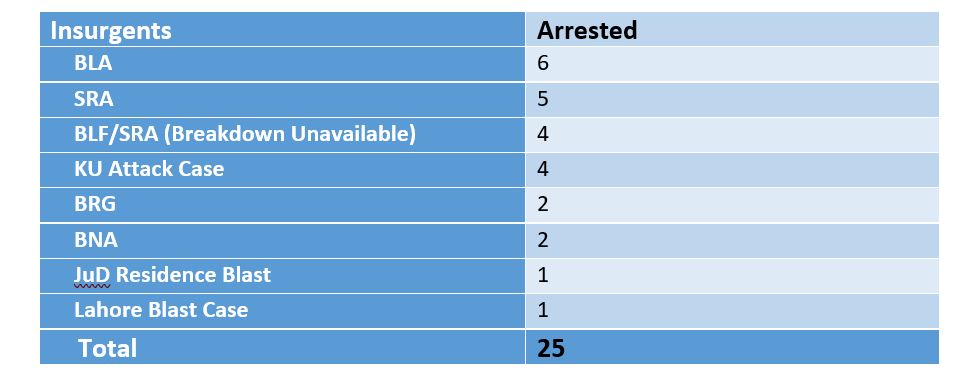
Despite a rise in militant attacks, the counter-terror security operations remained very low with a resultant gap between the number of casualties from security operations (379) and terror attacks (1326) (Table 09-A and Table 09-B).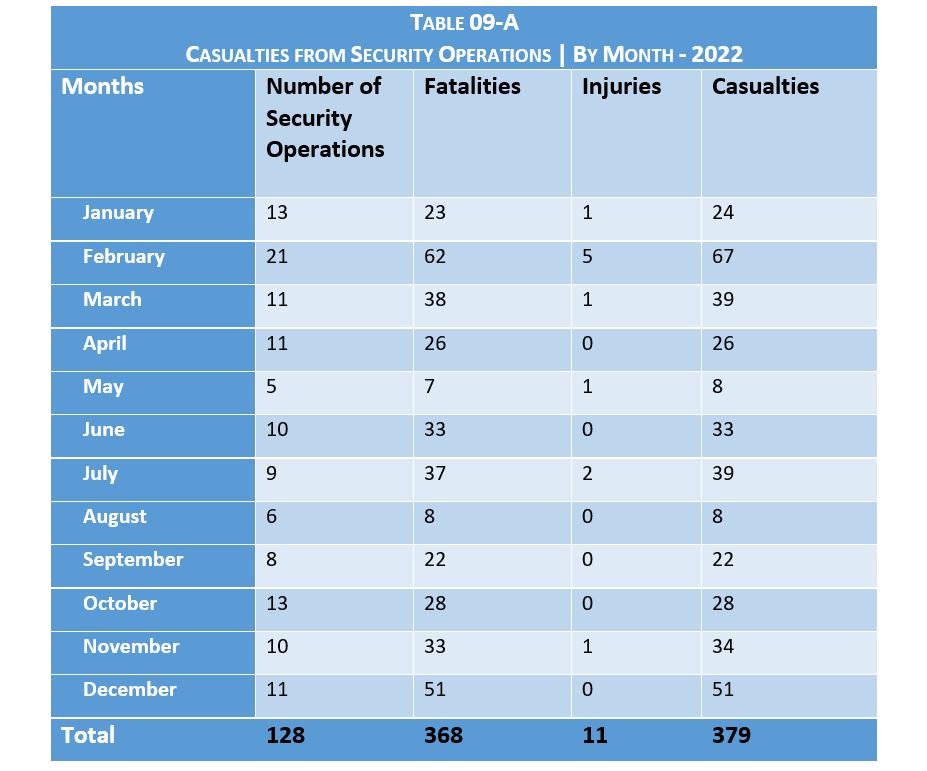
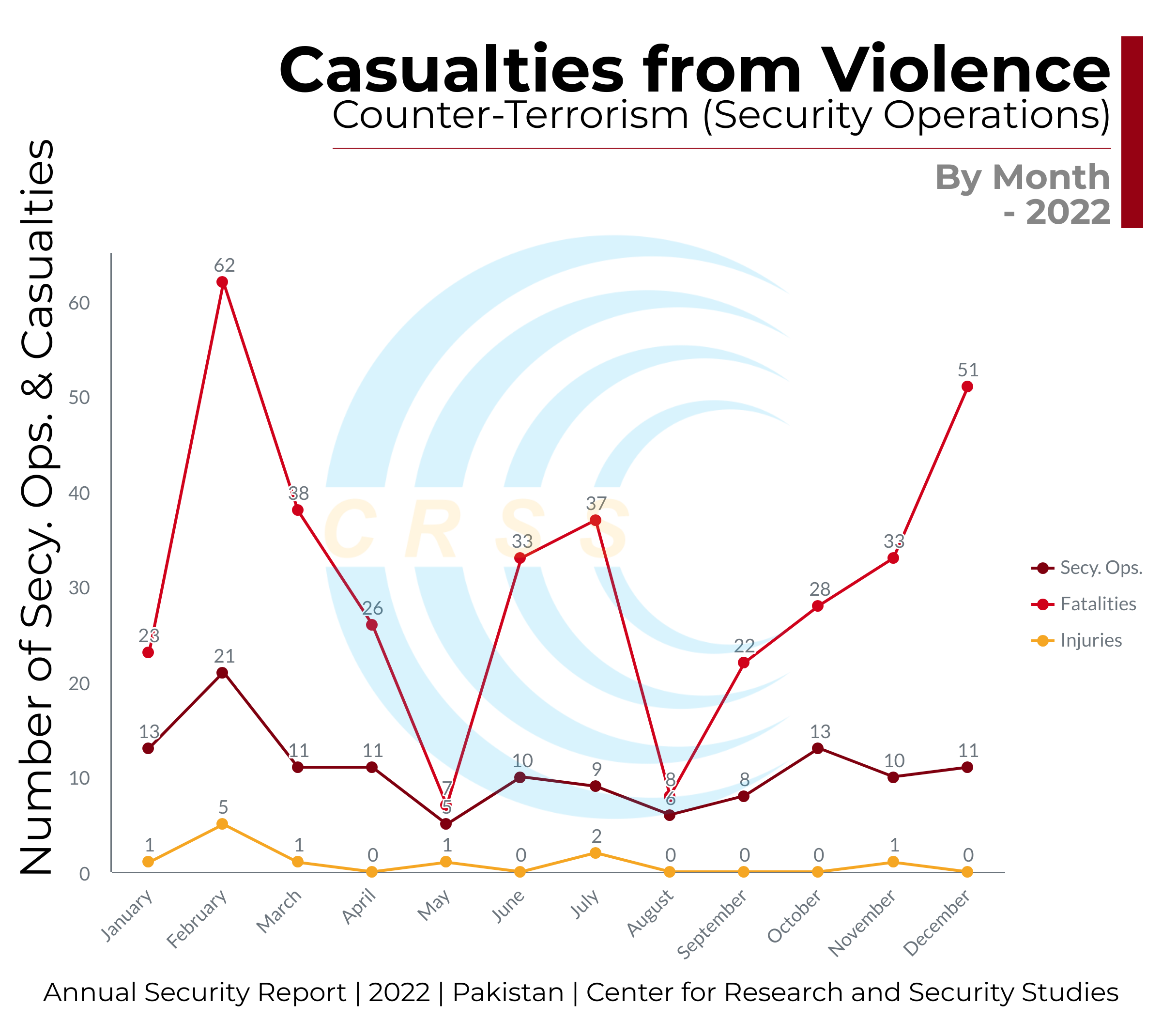
Terrorist Attacks
Since the Taliban’s return to power in Afghanistan, the TTP regained its strength by getting its prisoners released from Afghan jails.[1]
It also stitched partnerships and operational alliances with IS-K, AQ, Uighur extremist group ETIM[2], and a few Baloch insurgent groups that have made it an umbrella group of militants that has at least 22 other groups working with it now[3].
Several attempts by Pakistan to woo TTP into laying down remained futile until the group unilaterally called off the ceasefire. Previously, upon agreement, it resulted in some reduction in terrorist violence during May-August 2022 with about 270 casualties (149 fatalities and 121 injuries) (Table 09-B).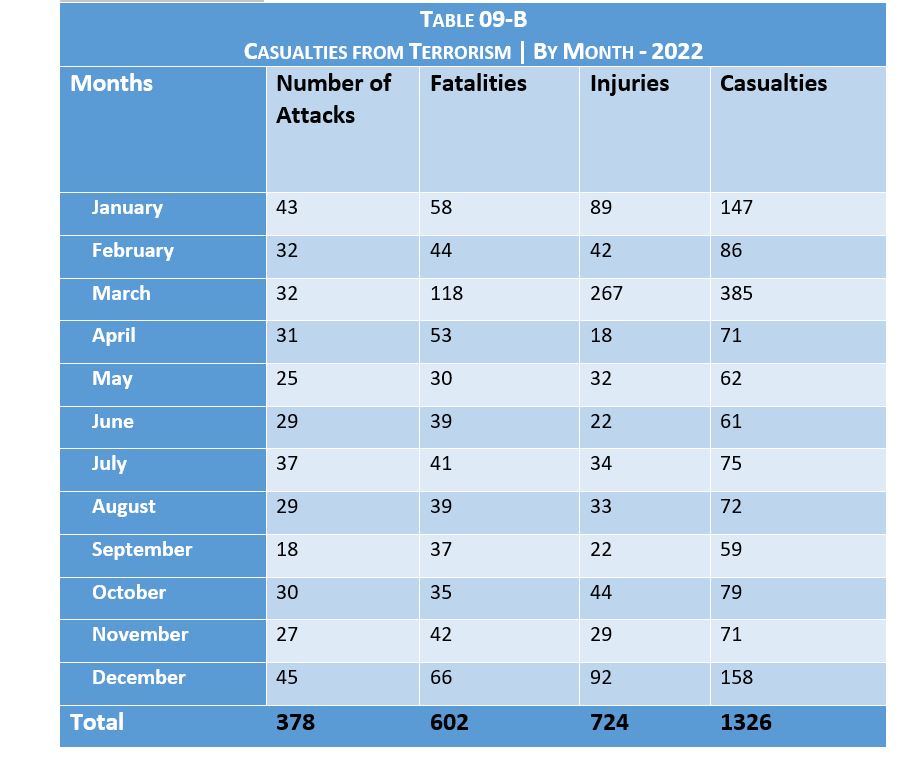

December was also the month when security agencies suffered the highest number of fatalities of personnel in a decade (Table 10).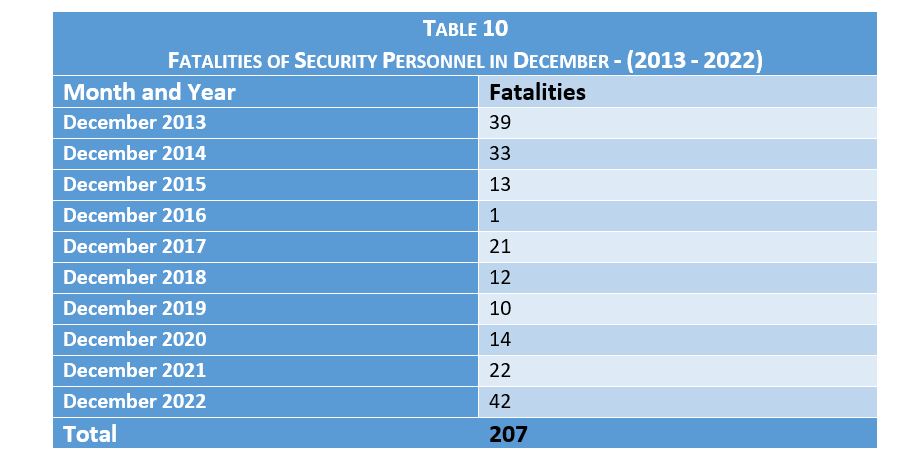
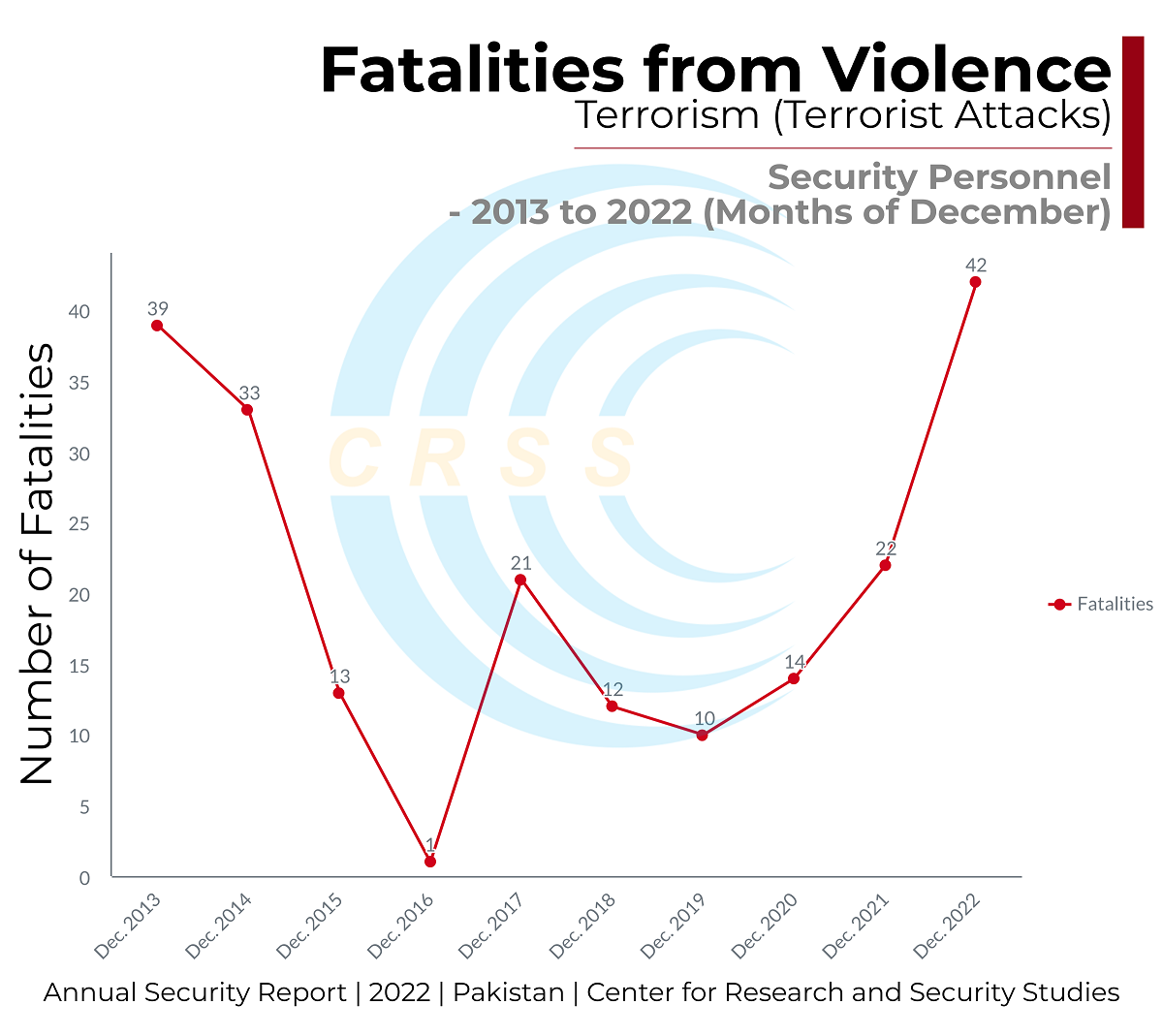 Country-wide casualties of terror attacks were 1326 (602 fatalities and 724 wounded). Of the 378 incidents of terrorism, 303 were recorded in two provinces only – KP (221) and Balochistan (82). The resultant casualties from these attacks in KP and Balochistan were the highest among all other provinces of the country (Table 11).
Country-wide casualties of terror attacks were 1326 (602 fatalities and 724 wounded). Of the 378 incidents of terrorism, 303 were recorded in two provinces only – KP (221) and Balochistan (82). The resultant casualties from these attacks in KP and Balochistan were the highest among all other provinces of the country (Table 11). 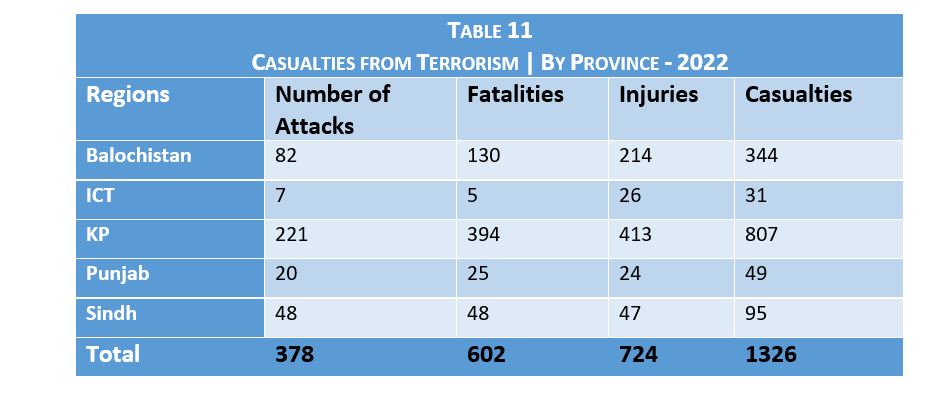
 While the security forces suffered a higher number of terror attacks, their casualties were less than civilian casualties because of the vulnerability of the civilian population. Some acts of terrorism resulted in the fatalities of militants, insurgents, and criminals because of mishandling of explosive material or infight. Two suicide bombers were killed in Islamabad when one of them detonated his device during the police investigation.
While the security forces suffered a higher number of terror attacks, their casualties were less than civilian casualties because of the vulnerability of the civilian population. Some acts of terrorism resulted in the fatalities of militants, insurgents, and criminals because of mishandling of explosive material or infight. Two suicide bombers were killed in Islamabad when one of them detonated his device during the police investigation.
Political leaders, their family members, and socio-political activists were also the target of terrorist violence, mostly because of political rivalries. Four members of religious parties became the target of sectarian violence as well.
Five foreigners, 4 Chinese (3 teachers at Karachi University and a dentist), and a former commander of the Afghan police also became targets of violence in the country. Two media persons, a crime reporter in a private TV channel and a journalist associated with Express Daily, were gunned down in Lahore and Charsadda respectively. This is the first time in a decade that the fatalities of security personnel were close to the civilian fatalities – security (291) and civilians (297). This phenomenon deserves additional study to understand the new evolving strategy of various terrorist outfits (Table 12).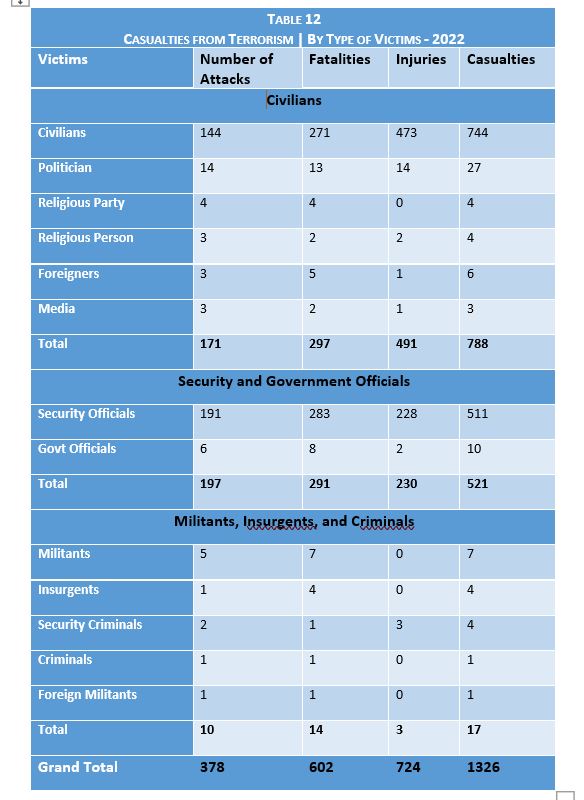
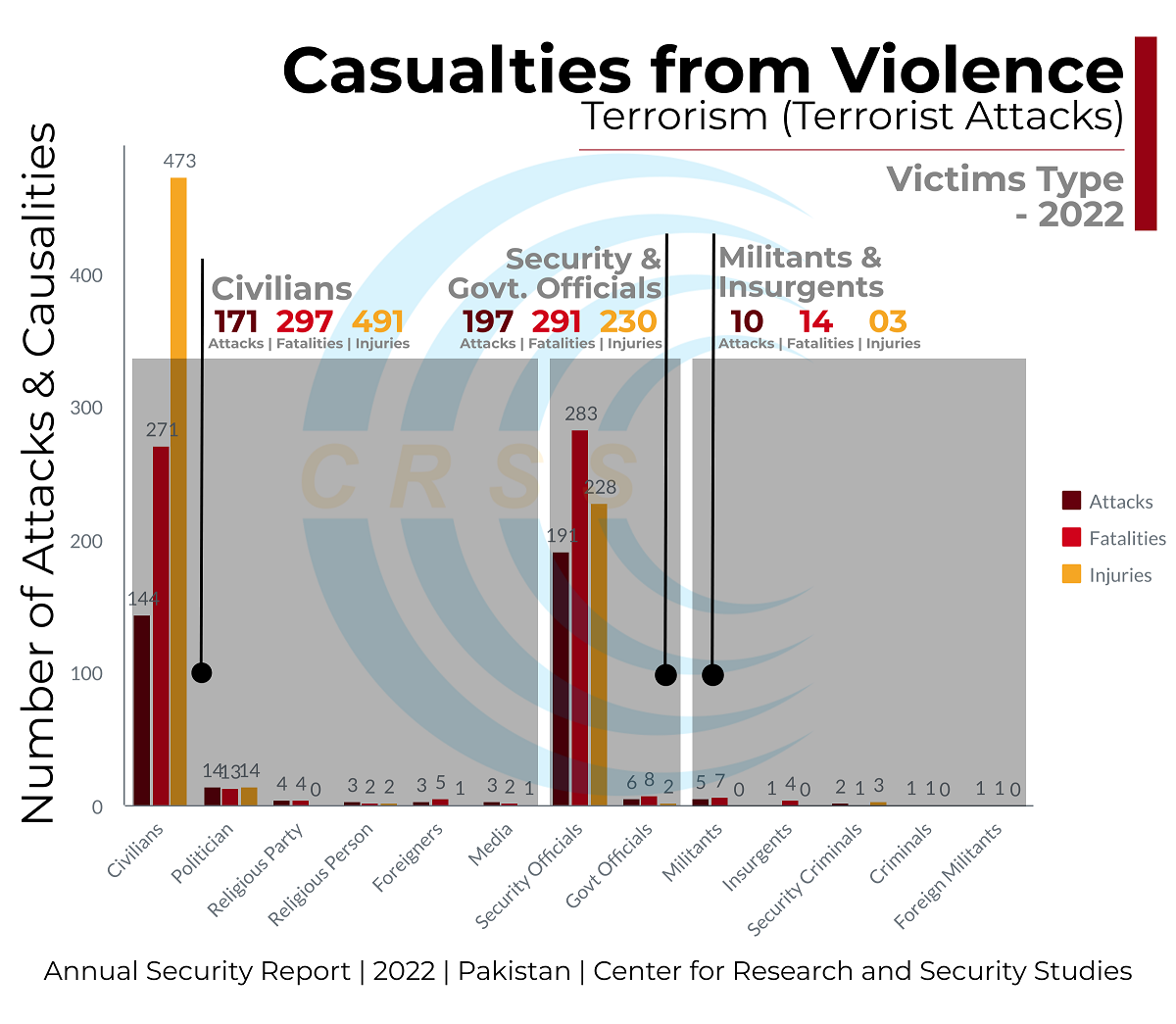 A breakup of security personnel’s fatalities brings forth a staggering result. Pak Army, Frontier Corps, and Levies lost 163 personnel while 129 of them were wounded compared to 218 casualties of policemen (119 fatalities and 99 wounded) (Table 13).
A breakup of security personnel’s fatalities brings forth a staggering result. Pak Army, Frontier Corps, and Levies lost 163 personnel while 129 of them were wounded compared to 218 casualties of policemen (119 fatalities and 99 wounded) (Table 13).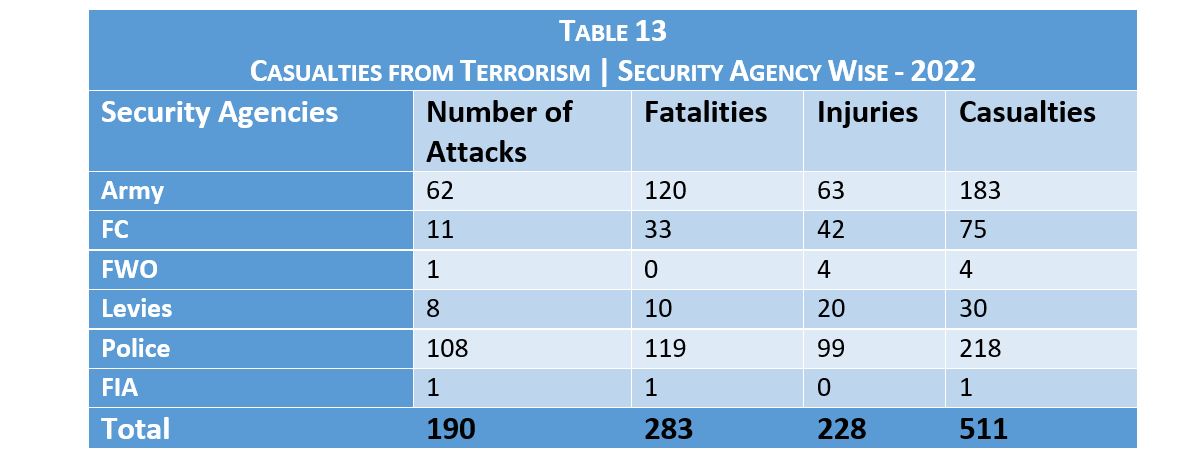
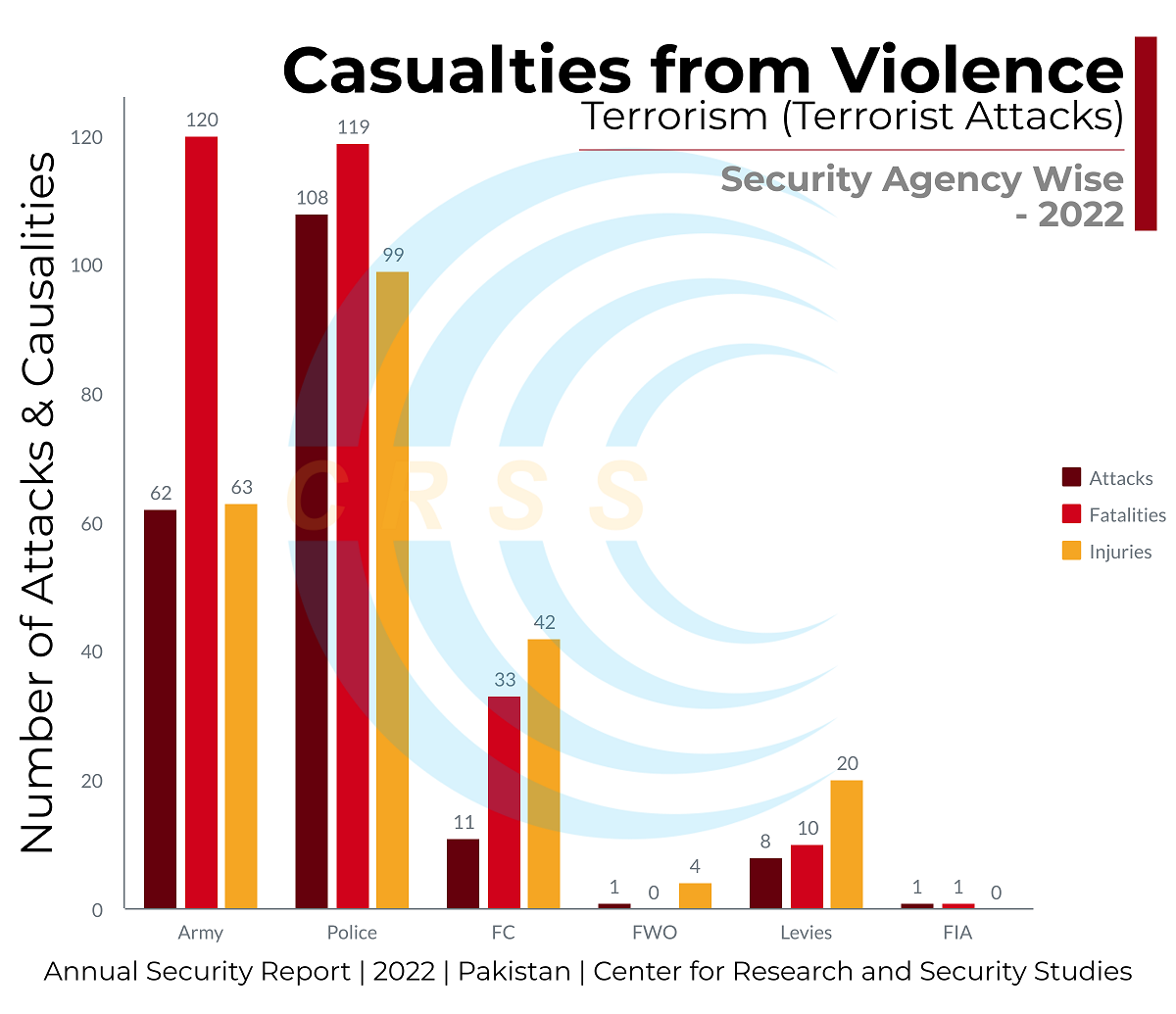 Province-wise data reveal that Balochistan and KP are the two regions where the army personnel were the highest victims of terror attacks than the policemen. The other three regions, ICT, Punjab, and Sindh, showed 13 fatalities of policemen and zero for army personnel (Table 14).
Province-wise data reveal that Balochistan and KP are the two regions where the army personnel were the highest victims of terror attacks than the policemen. The other three regions, ICT, Punjab, and Sindh, showed 13 fatalities of policemen and zero for army personnel (Table 14).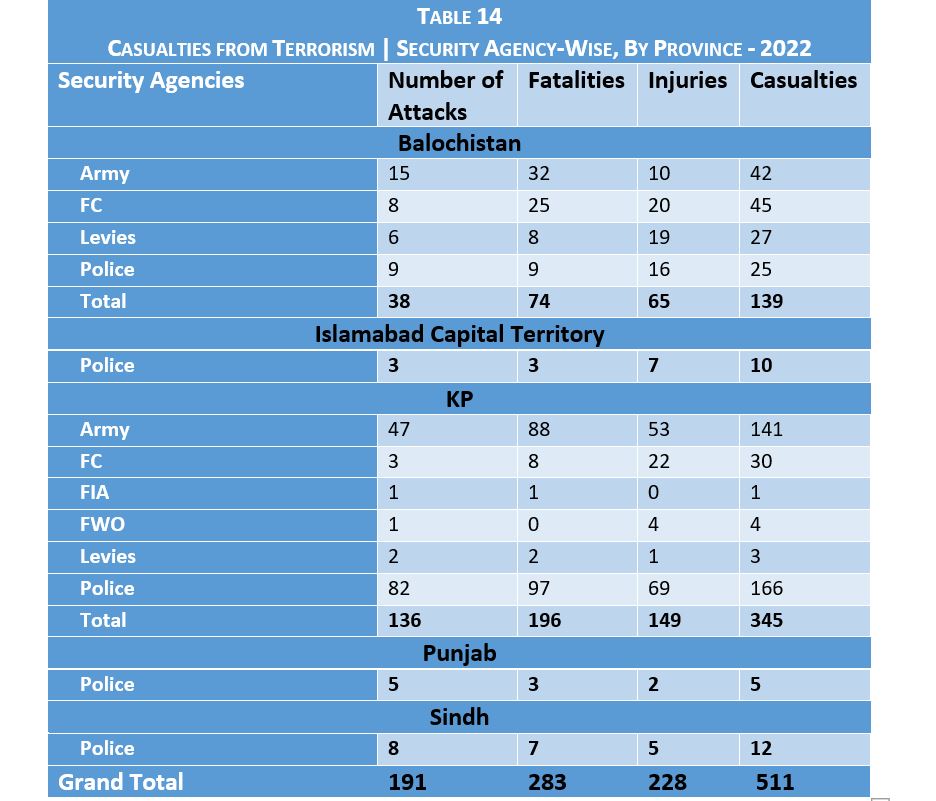
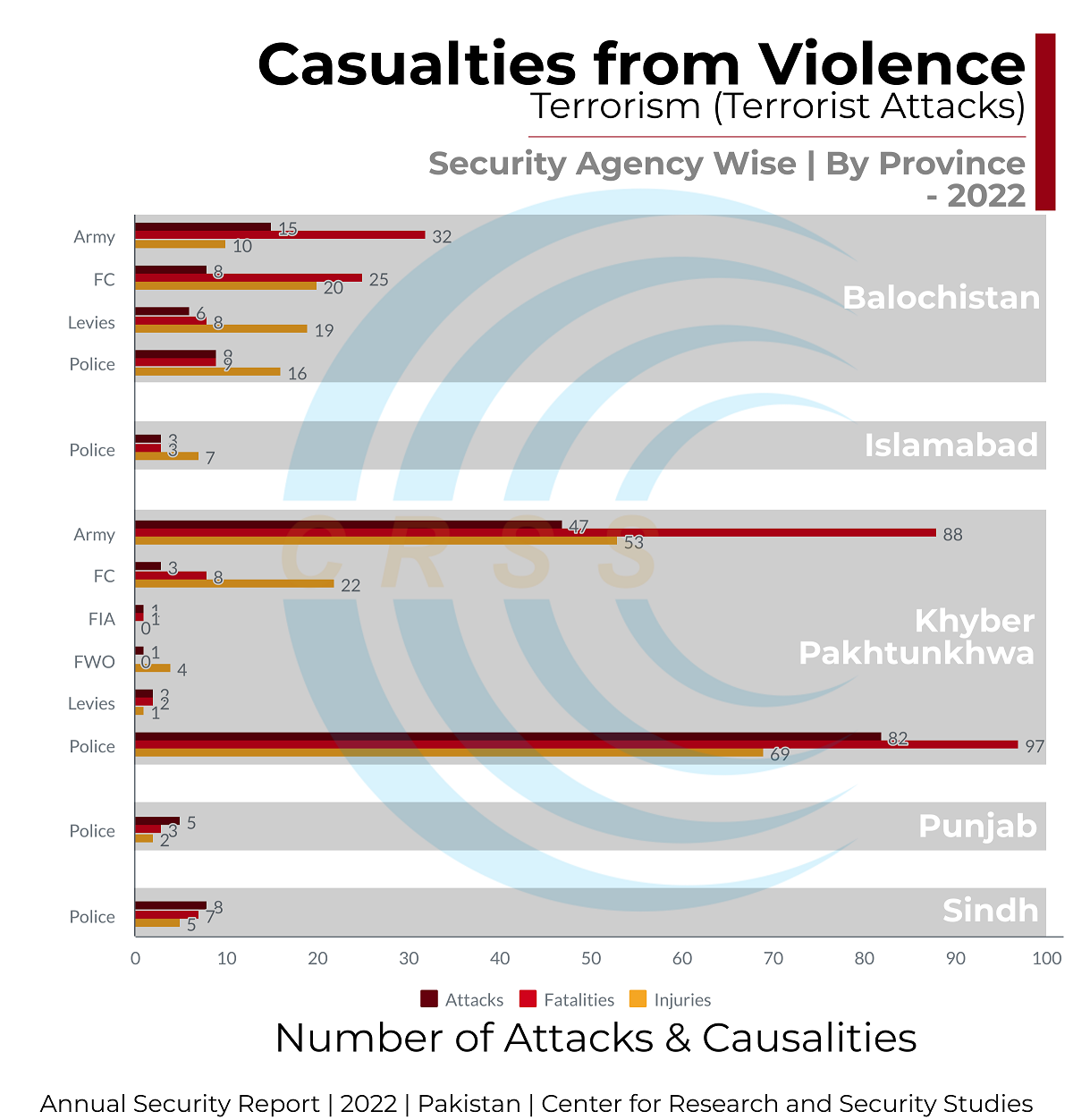
The methods and armaments used by the militants for their political and criminal actions varied in their forms and nature. They included armed attacks, ambushes, suicide attacks, sniper shootings, and kidnapping and killing of the targets. Explosive materials like landmines, hand grenades, bombs, mortar shells, and IEDs were also used commonly in the country. In one case, an anti-tank mine was also used posing new threats even to armored vehicles. A significant rise in suicide attacks was also observed as its number went up to 12 this year compared to two suicide attacks in 2021. Militants living in Afghanistan also carried out several cross-border attacks leaving 22 security persons dead and 15 injured (Table 15).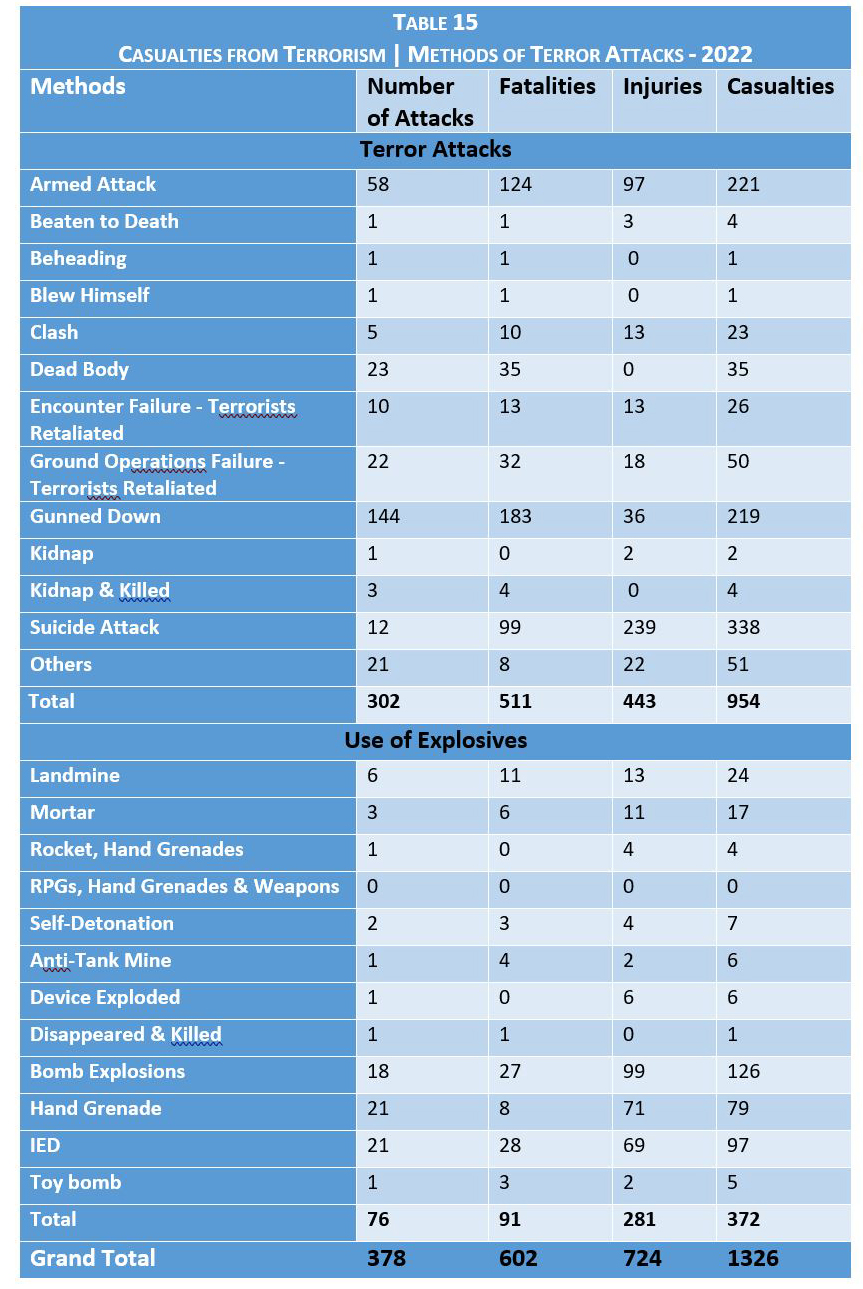
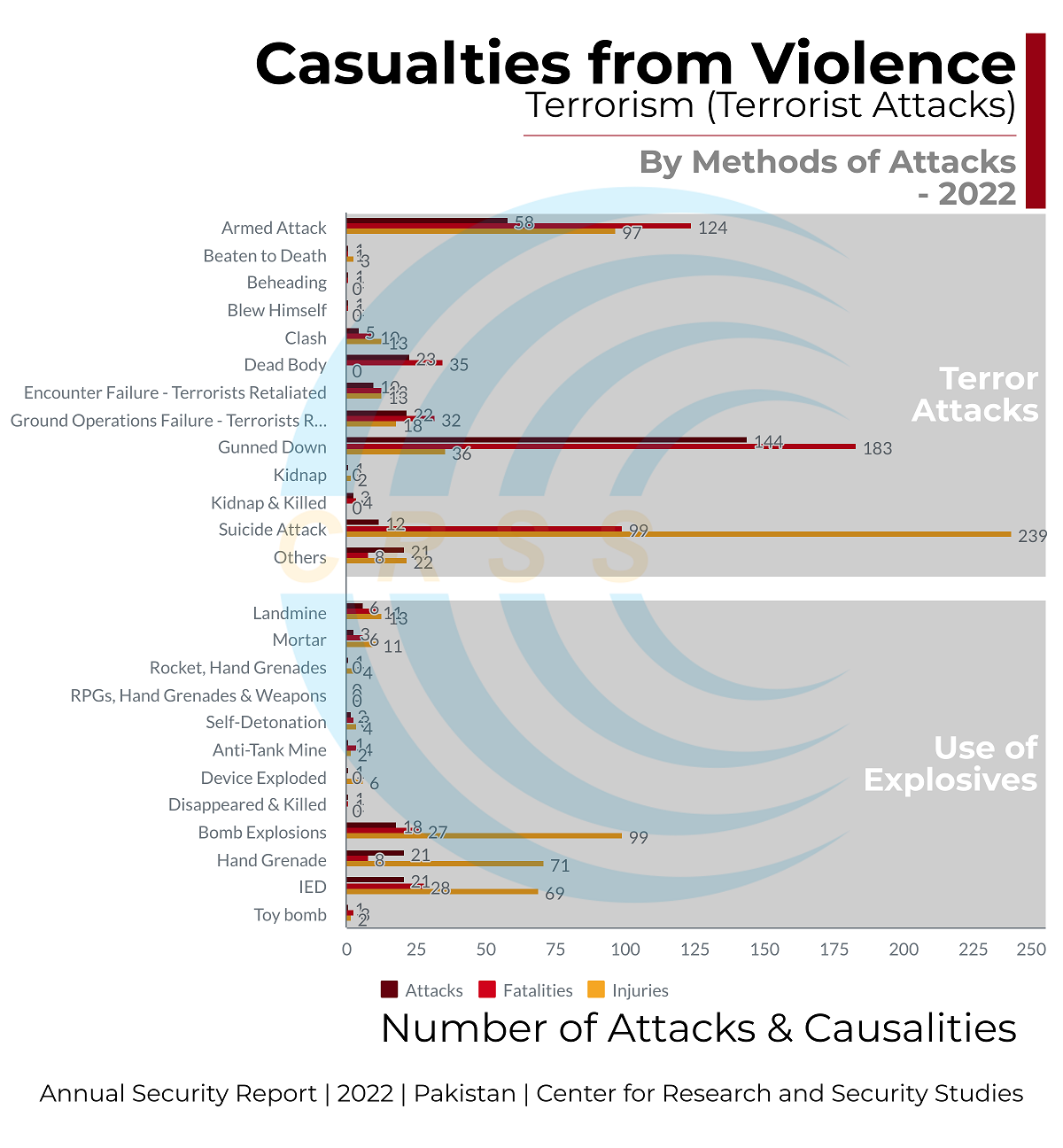 Fatalities from Terror Attacks and Counter-Terror Operations – Breakdown by Regions and Districts
Fatalities from Terror Attacks and Counter-Terror Operations – Breakdown by Regions and Districts
Balochistan
Kech district in Balochistan suffered the highest number of fatalities from terror and counter-terror incidents followed by Quetta, Sibi, Nushki, Panjgur, Hoshab, Kohlu, Ziarat, Harnai, and many other districts where the fatalities were less than two digits. The total fatalities from terror attacks were higher than the fatalities from security operations in the province – 130 versus 124 respectively (Table 16).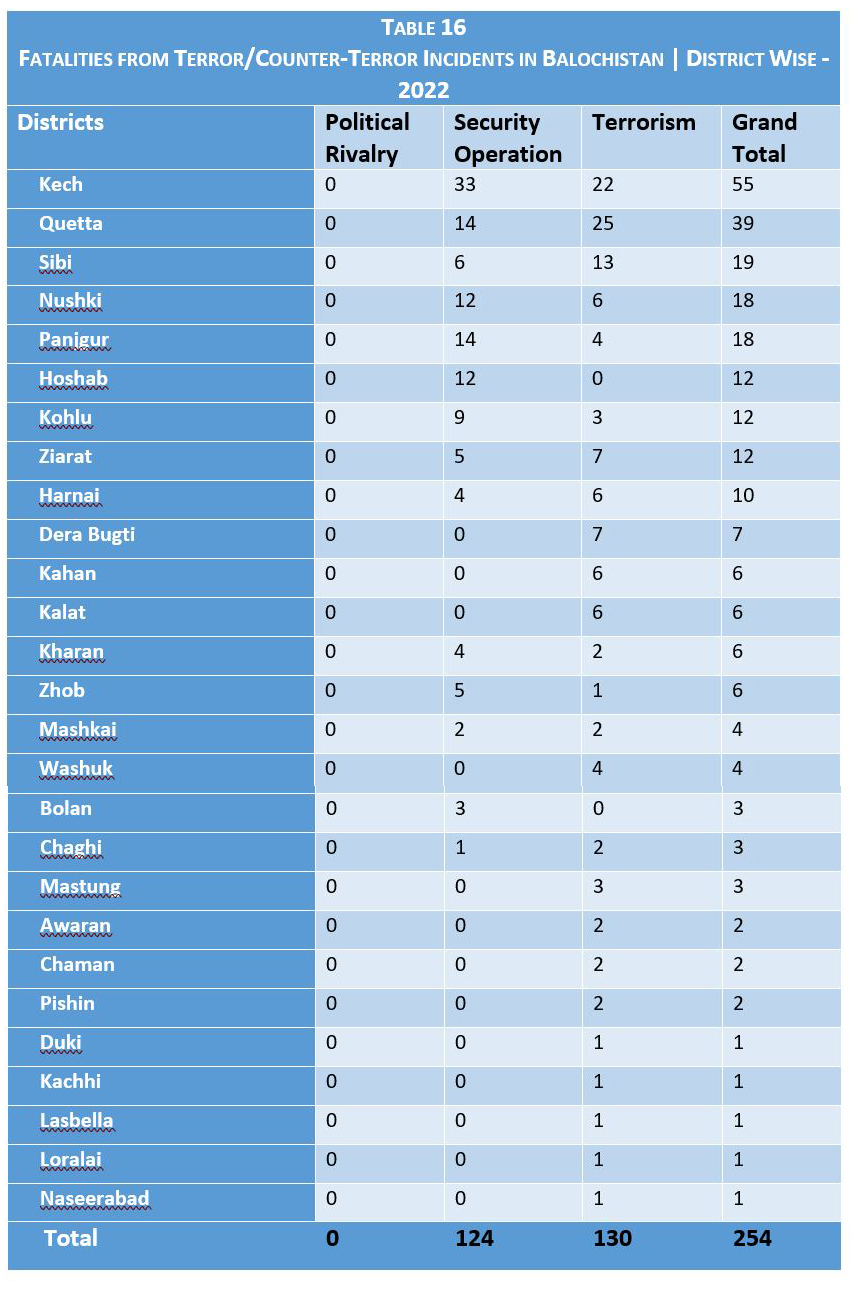

Khyber Pakhtunkhwa
In KP, the Bajaur district had the highest number of fatalities from terror and counter-terror operations. Bannu, Charsadda, D.I. Khan, Dir, Hangu, Haripur, Hazara, Khyber, Kohat, Kurram, and Lakki Marwat suffered two-digit fatalities. Fatalities from terror attacks were higher than from security operations (Table 17).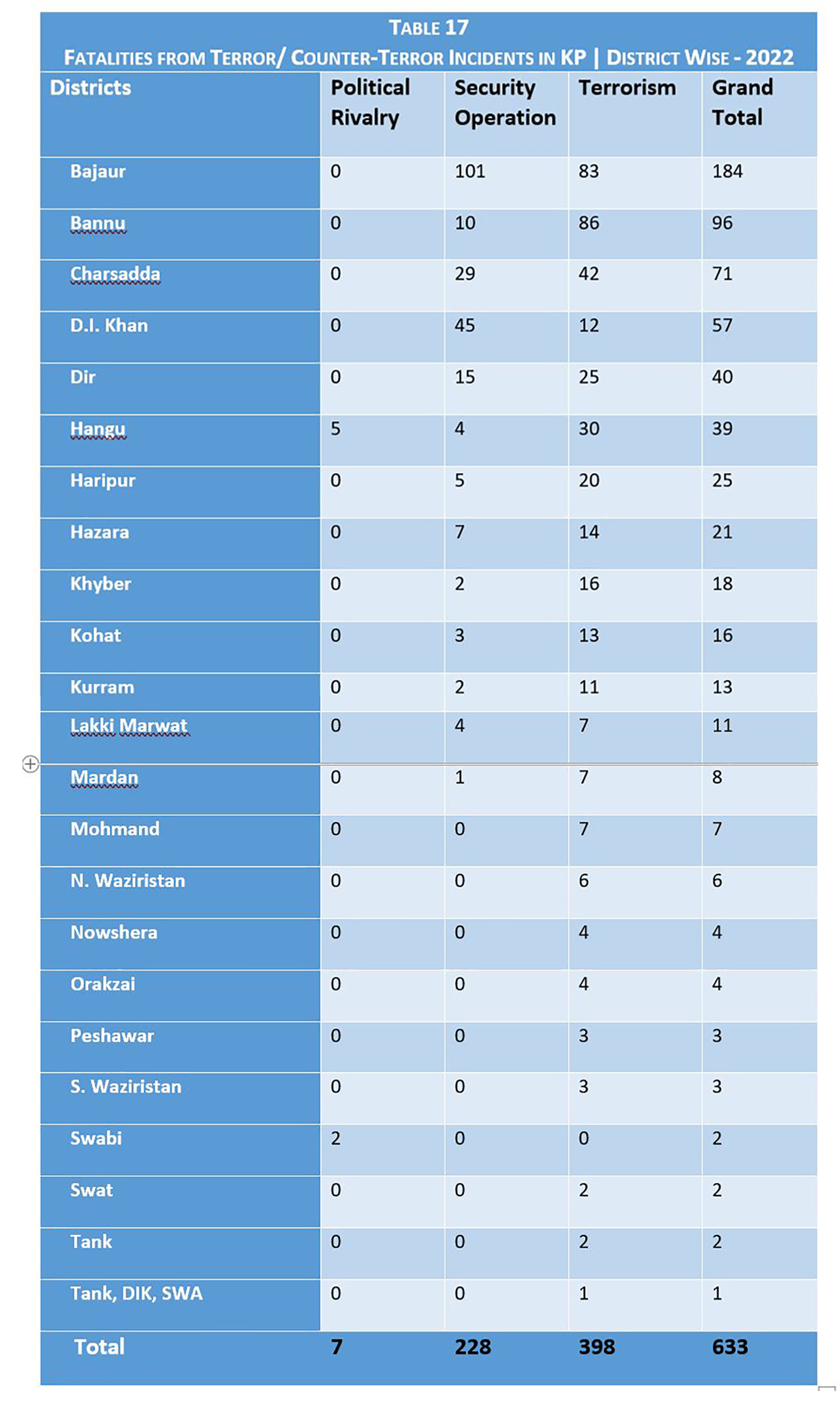
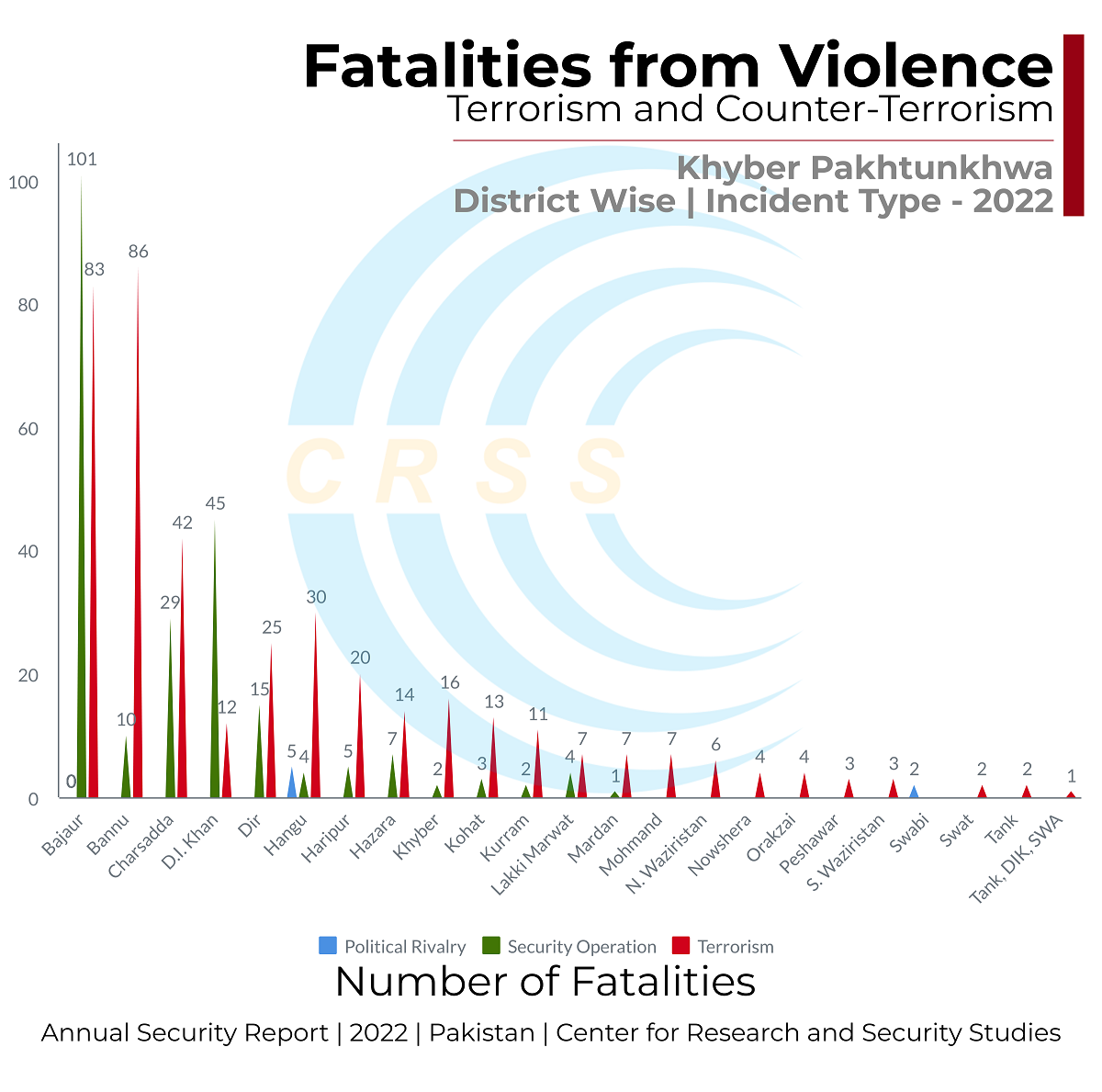 Punjab
Punjab
In the Punjab province, all districts had fatalities from terror attacks except in Narowal where one outlaw was eliminated in security operations. Lahore had the highest number of fatalities in the province (Table 18).
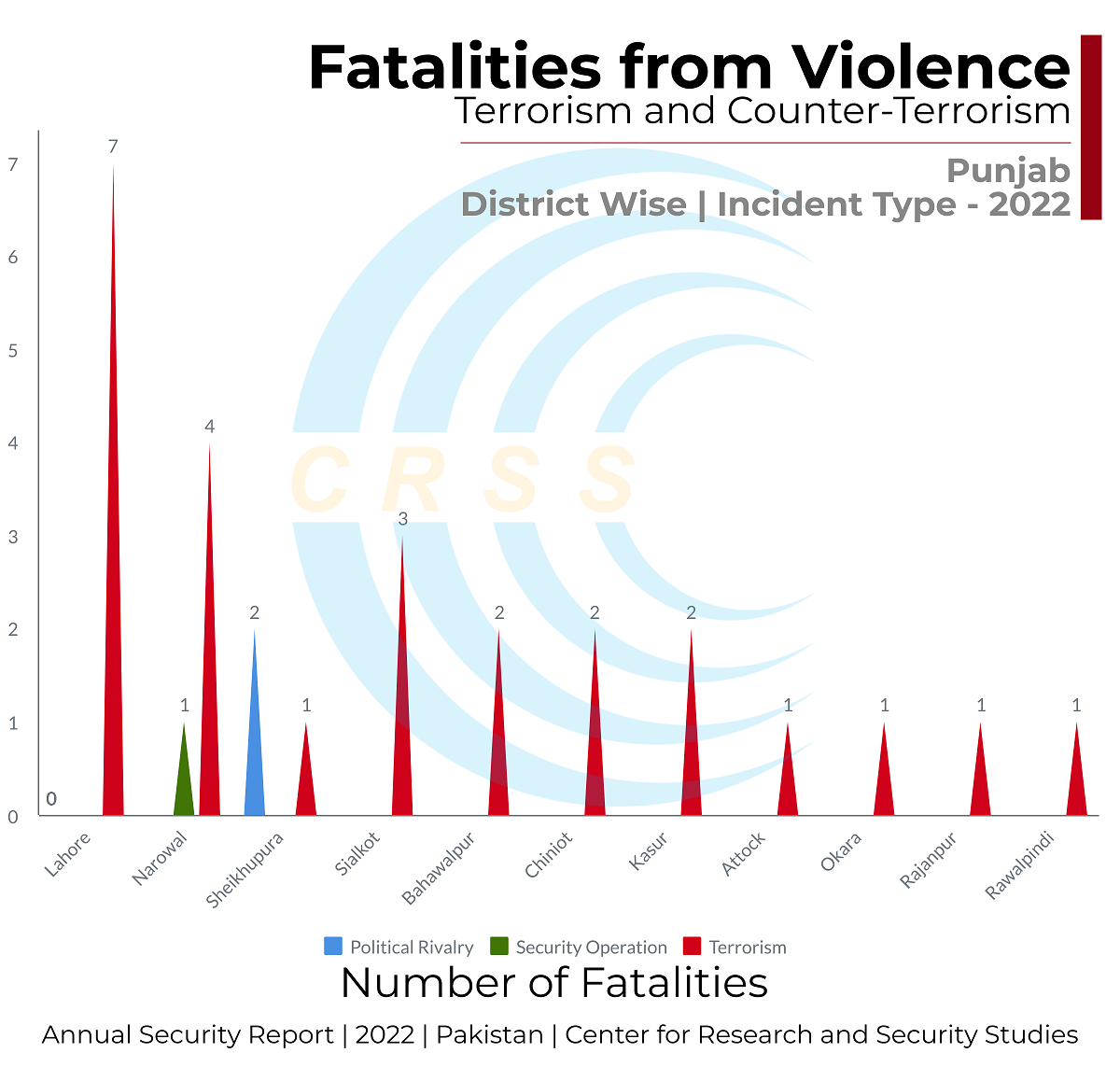
Sindh
Karachi district suffered nearly 80% fatalities from terror and counter-terror incidents in Sindh followed by Ghotki, Sukkur, Jacobabad, and others. Only eight outlaws were eliminated against 48 fatalities from terror attacks in Sindh (Table 19).
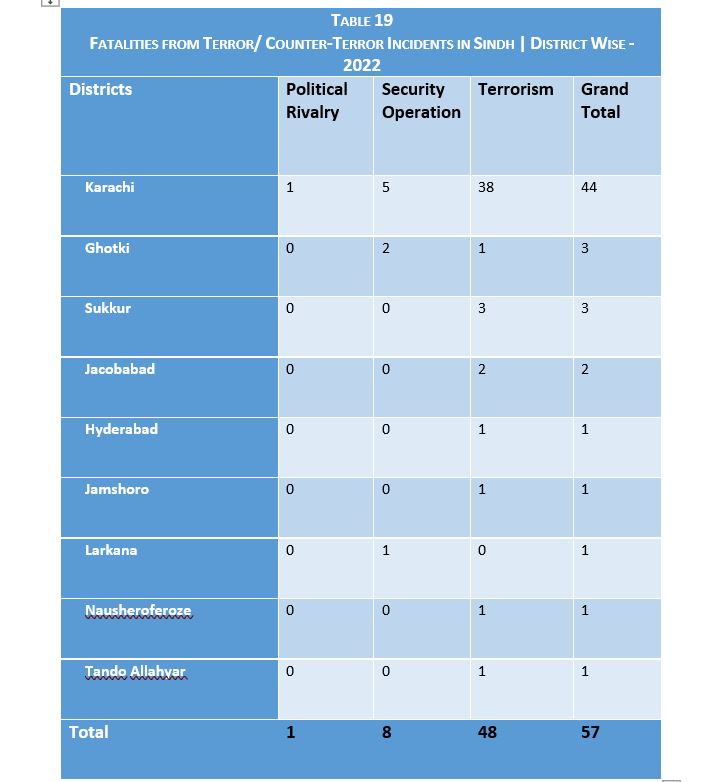
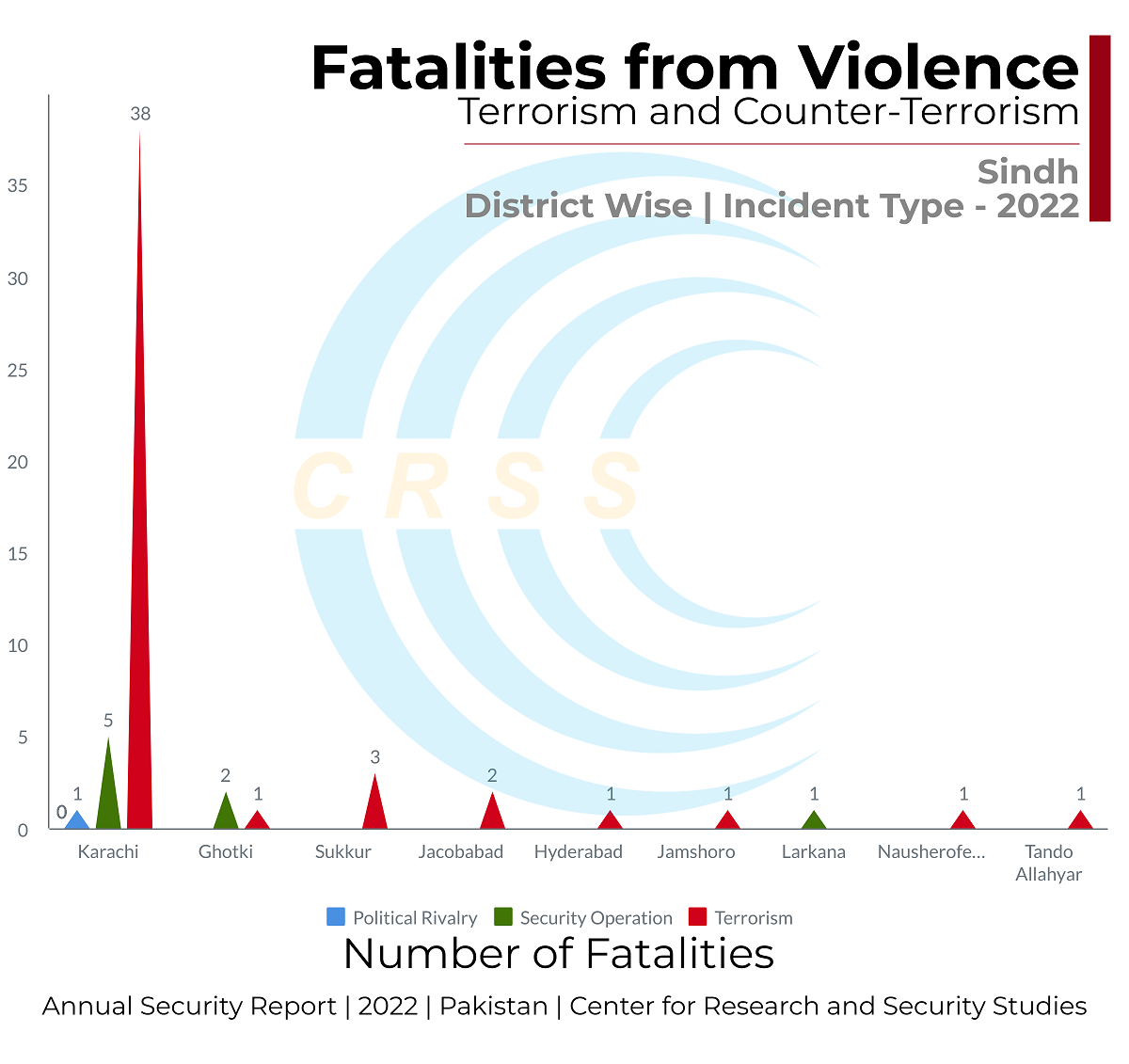
ICT, AJK, and GB
Zero fatalities related to the incidents of terrorism and counter-terrorism operations were reported from AJK and Gilgit Baltistan while ICT counted 8 fatalities and 35 such casualties during this year (Table 20).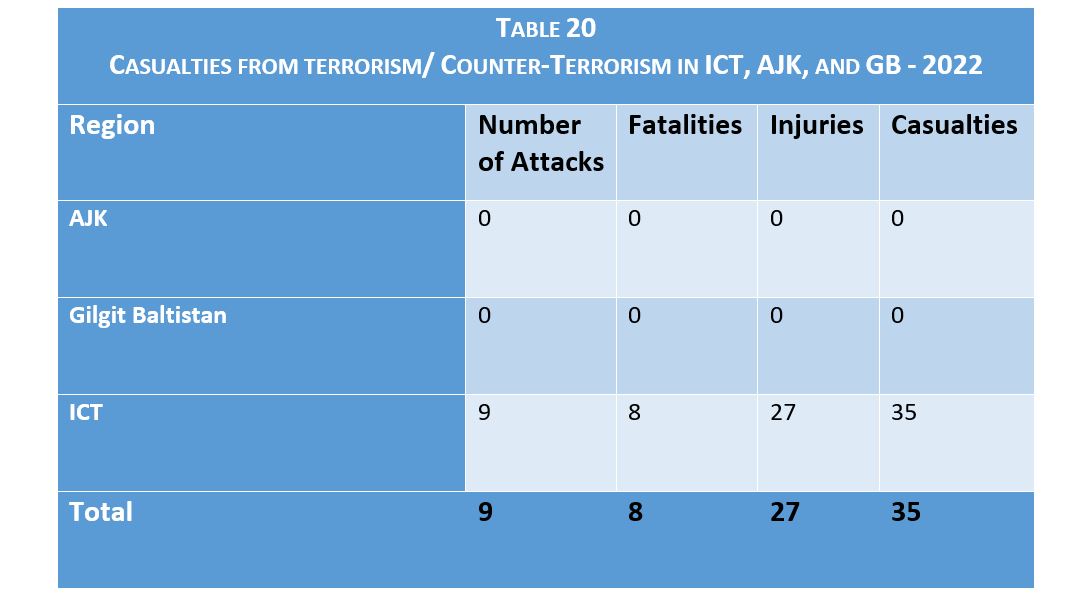
Police in the capital Islamabad thwarted a suicide attack claimed by the TTP. When intercepted, the suicide bomber triggered his device. A raid conducted by the Eagle Squad on a drug baron’s hideout in Shehzad Town resulted in a cross-fire and left a young police constable dead (Table 21).
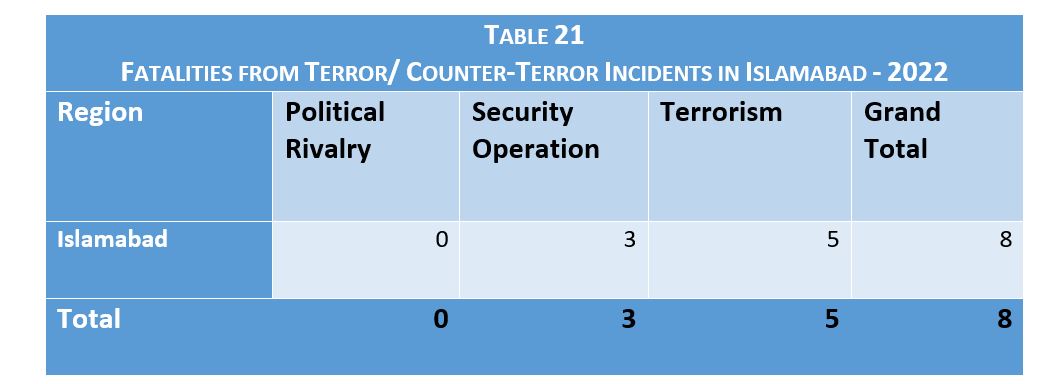
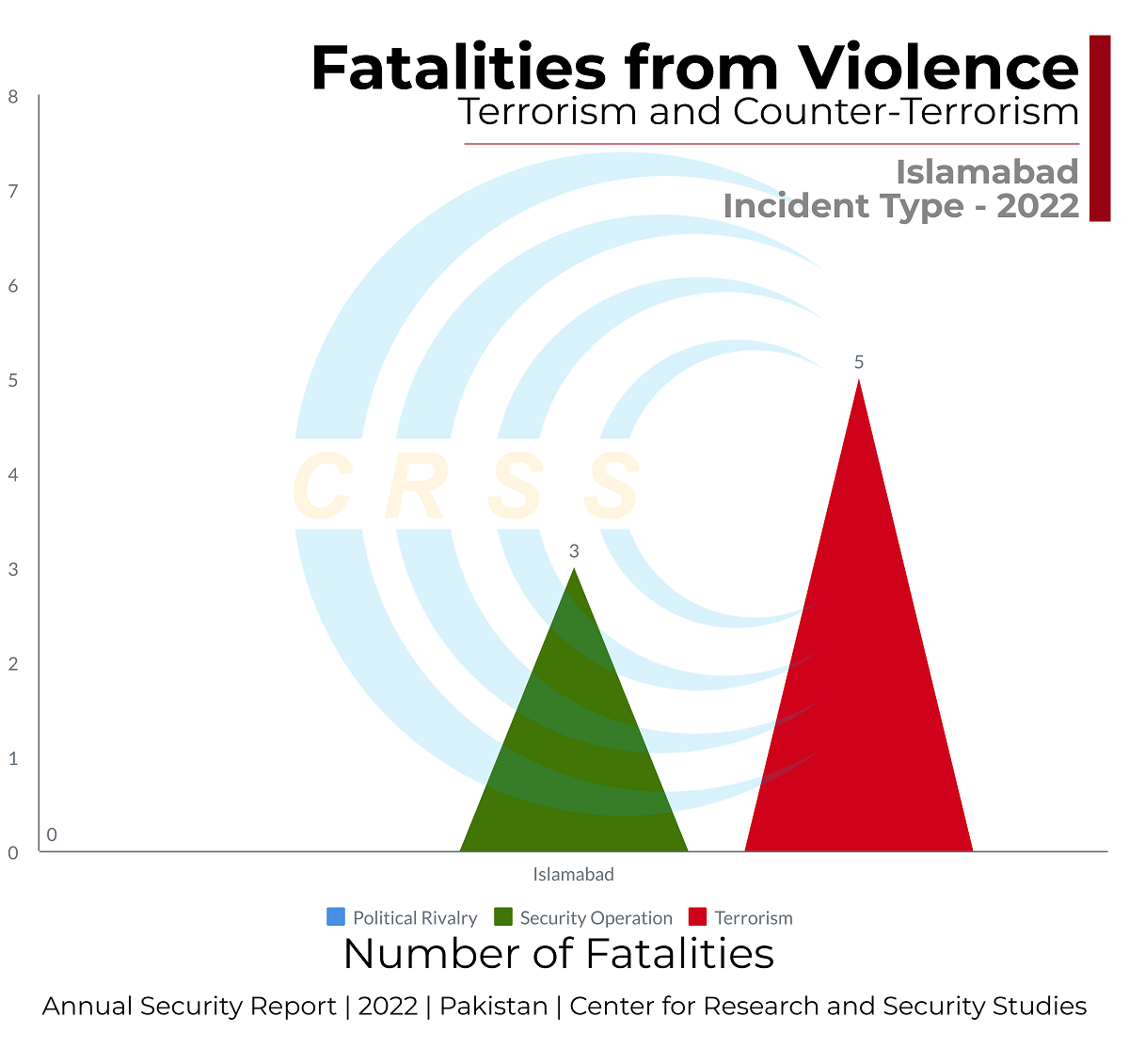 Casualties from Sectarian Violence
Casualties from Sectarian Violence
As many as 292 persons fell victim to sectarian violence in 2022; some 86 lost their lives while 206 were injured. The Shia community suffered the highest number of casualties while the Sunni community was the second largest victim of sectarian violence. Christians, Hindus, and Sikhs were also among the victims of sectarian violence this year (Table 22).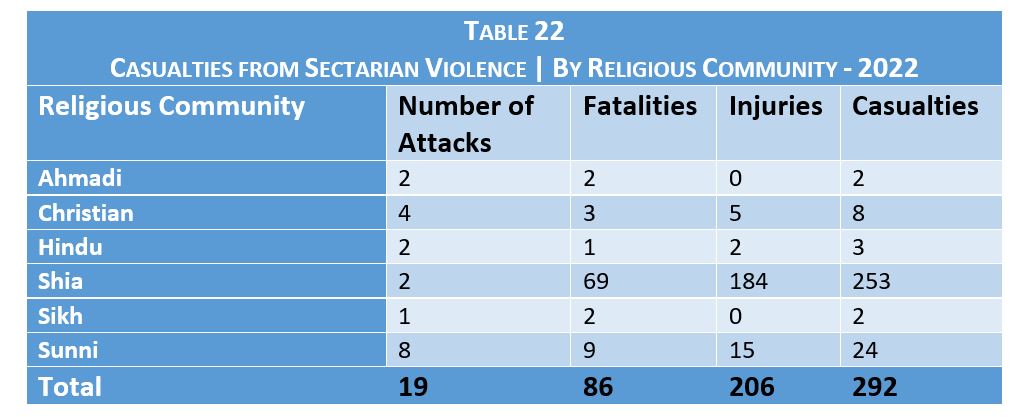
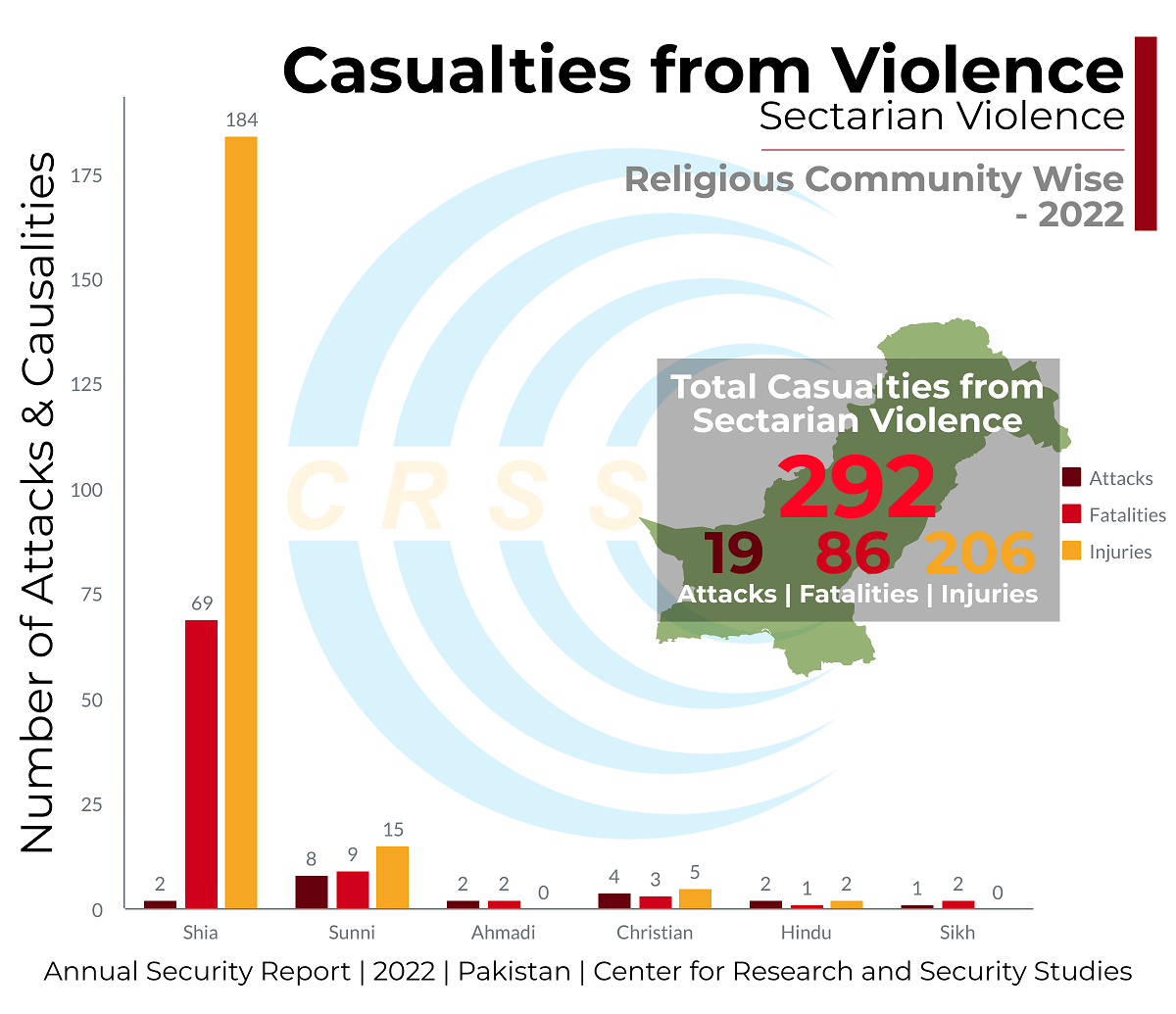
Terror attacks and target killings driven by sectarian hatred were reported from three provinces. KP had the highest number of casualties (79 dead and 200 wounded), followed by Punjab (3 dead and 4 injured) and Sindh (4 dead and 2 injured) (Table 23).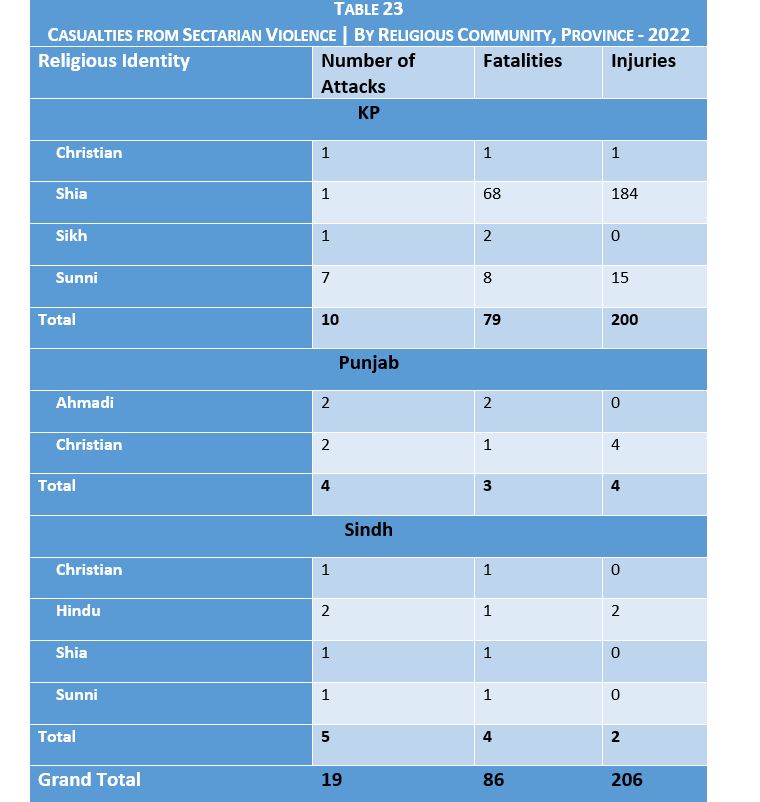
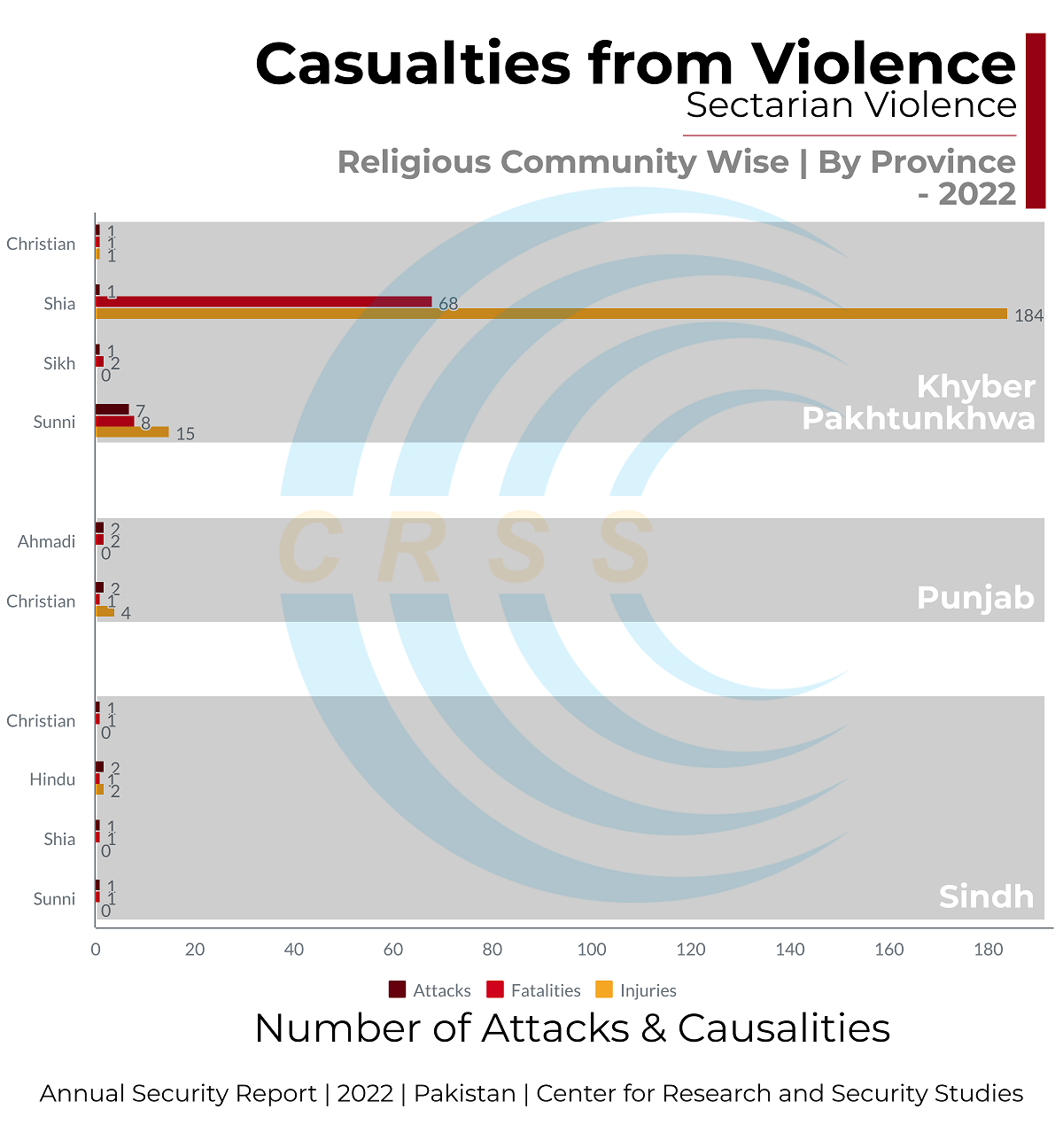 Most victims of sectarian violence were the common people belonging to different religious faiths and attached to religious parties or religious activities (Table 24).
Most victims of sectarian violence were the common people belonging to different religious faiths and attached to religious parties or religious activities (Table 24). A deadly suicide attack at the Imamia Mosque in Koocha Risaldar in Peshawar – leaving 68 dead and 184 injured – was claimed by IS-K. Four militants, reportedly involved in the attack, were later killed in Peshawar. In Lahore, a mob beat a young Christian to death following a petty dispute with some Muslim youngsters. A madrassa student stabbed a young Ahmadi in Okara to death, while a Hafiz and follower of Tehreek-e-Labbaik Pakistan murdered an Ahmadi in broad daylight in Chiniot. During a Friday prayer, a man opened fire at worshippers, killing 1 person and 11 injuring another in Lakki Marwat (KP) because of personal enmity. A Hindu family was attacked and injured in Mirpur Mathelo (Sindh) on a petty matter by the people who were accompanying Dr. Shamsher Pitafi, a cousin of Sindh Minister Livestock and Fisheries (Table 25).
A deadly suicide attack at the Imamia Mosque in Koocha Risaldar in Peshawar – leaving 68 dead and 184 injured – was claimed by IS-K. Four militants, reportedly involved in the attack, were later killed in Peshawar. In Lahore, a mob beat a young Christian to death following a petty dispute with some Muslim youngsters. A madrassa student stabbed a young Ahmadi in Okara to death, while a Hafiz and follower of Tehreek-e-Labbaik Pakistan murdered an Ahmadi in broad daylight in Chiniot. During a Friday prayer, a man opened fire at worshippers, killing 1 person and 11 injuring another in Lakki Marwat (KP) because of personal enmity. A Hindu family was attacked and injured in Mirpur Mathelo (Sindh) on a petty matter by the people who were accompanying Dr. Shamsher Pitafi, a cousin of Sindh Minister Livestock and Fisheries (Table 25).
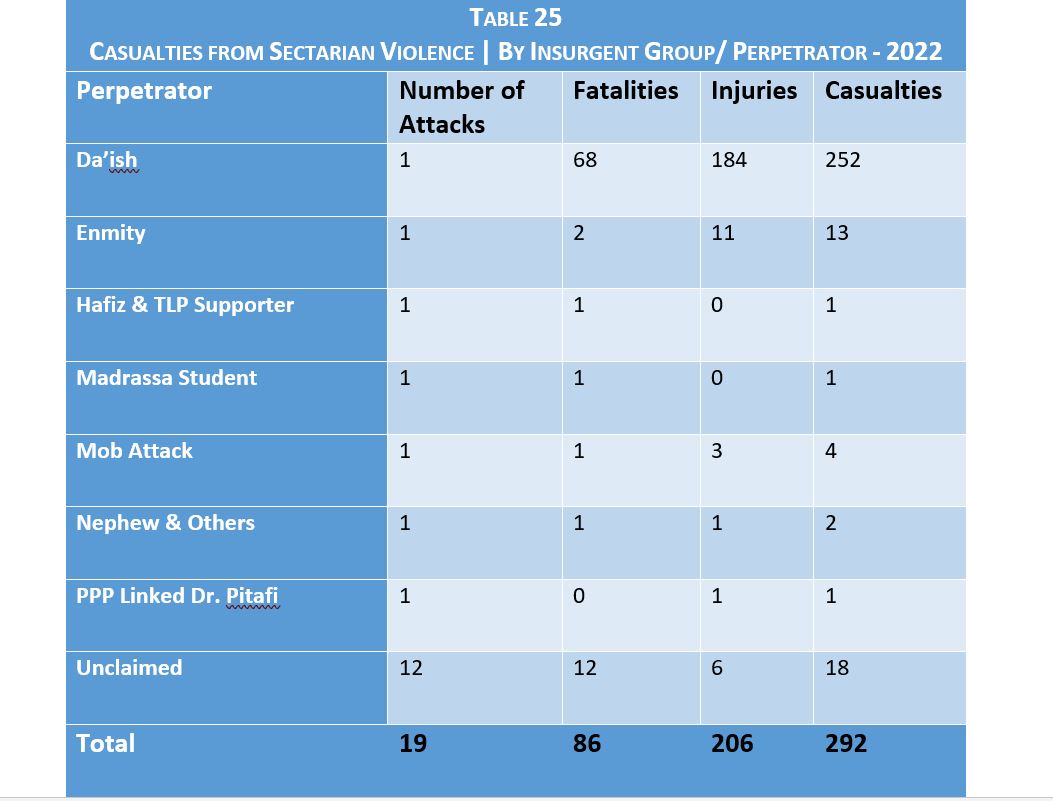
 Major Trends During 2022
Major Trends During 2022
With the return of proxy terrorist violence in the latter part of 2022, alarming trends can be discerned as far as Pakistan’s security challenges in 2022 were concerned:
- Most of the terrorist violence originated from eastern Afghanistan, officials claimed, with top TTP militants enjoying the hospitality of Afghan Taliban.
- Even the Afghan Taliban revived the issue of the Durand Line and began questioning as well as puncturing the border fence that had been erected at a cost of $ 500 million.
- Security forces remained the primary target of terrorist attacks in KP and Balochistan.
- The TTP, BLA, and Da’esh (IS-K) emerged as the most vicious triad that led to the surge in terror across the country.
- KP bore brunt of the unprecedented spike in violence in over a decade, with a 59% uptick in human losses.
- Most of the terrorist strikes are concentrated in the Greater Bannu region that is adjacent to Waziristan, Bajaur, and Kurram districts. These districts directly abut Afghan provinces Kunar, Nangarhar, Paktia, and Paktika, and thus serve as a springboard for terrorist missions into the Pakistani mainland.
In 2023, Pakistan is likely to endure more violence. The pattern over the last decade suggests that the security forces including the army and police as well as KP and Balochistan provinces will remain under terrorist violence. Also, these challenges are likely to persist as long as terrorist outfits enjoy safety in Afghanistan.
Download PDF
[1] https://nayadaur.tv/2021/08/afghan-taliban-release-ttp-prisoners-after-taking-over-bagram-airbase/
[2] https://www.dawn.com/news/1674294/un-report-on-terrorism
[3] https://tribune.com.pk/story/2392466/new-militant-group-joins-ttp
[1] https://e.thenews.com.pk/detail?id=72324
[2] https://www.dawn.com/news/1671625/13-linked-to-foreign-spy-agency-held
[3] https://arynews.tv/raw-cyber-network-karachi-sufyan-naqvi-investigators/amp/
[4] https://tribune.com.pk/story/2356858/police-foil-suspected-suicide-attack-against-chinese-nationals-in-balochistan
[5] https://tribune.com.pk/story/2356858/balochistan-ctd-arrests-female-would-be-bomber
[1] https://www.thenews.com.pk/print/951723-mengal-declines-ministry-in-protest-against-chaghi-incident
[2] https://8am.media/eng/taliban-commander-along-with-a-fighter-controversially-disappeared-killed-in-peshawar-pakistan/
[3] https://tribune.com.pk/story/2347027/three-terrorists-involved-in-peshawar-imambargah-attack-killed-in-encounter
[4] https://tribune.com.pk/story/2356601/mastermind-of-peshawar-imambargah-attack-killed-in-ibo-officials
[5] https://tribune.com.pk/story/2377023/three-daish-militants-killed-in-ctd-raid-near-pak-afghan-border
[6] https://tribune.com.pk/story/2380854/terrorists-killed-in-swat-were-trained-in-afghanistan
[7] https://tribune.com.pk/story/2390476/four-daish-terrorists-killed-in-pak-afghan-border-ibo
[8] https://tribune.com.pk/story/2347007/seven-externally-sponsored-enemies-of-peace-killed-in-balochistan
[9] https://www.dawn.com/news/1681006/ex-fc-man-who-shot-three-cops-killed-in-encounter

